
The Project Gutenberg EBook of Choffard, by Vera Salomons This eBook is for the use of anyone anywhere in the United States and most other parts of the world at no cost and with almost no restrictions whatsoever. You may copy it, give it away or re-use it under the terms of the Project Gutenberg License included with this eBook or online at www.gutenberg.org. If you are not located in the United States, you'll have to check the laws of the country where you are located before using this ebook. Title: Choffard Author: Vera Salomons Release Date: January 16, 2015 [EBook #47998] Language: English Character set encoding: UTF-8 *** START OF THIS PROJECT GUTENBERG EBOOK CHOFFARD *** Produced by Chris Curnow, Denis Pronovost and the Online Distributed Proofreading Team at http://www.pgdp.net (This file was produced from images generously made available by The Internet Archive)

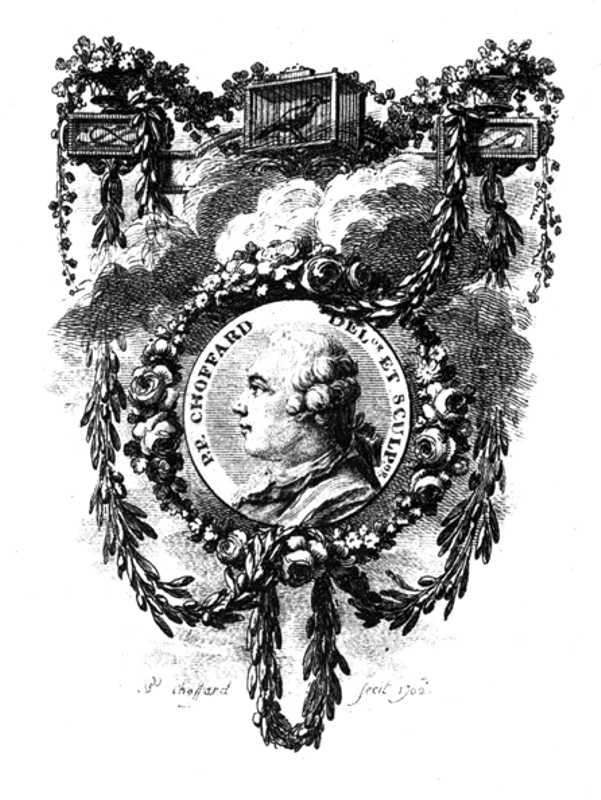
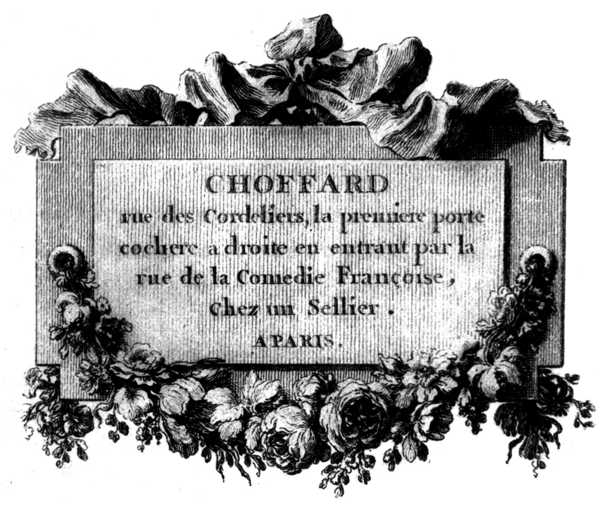
You may never have heard of Choffard and never have seen his work, but if any production from his hand should be brought before your eyes, however insignificant, and you fail to admire it, then it is to confess that no artistic corner exists in your soul!
Of all the vignettists, Choffard is the freshest, most ingenious, and charming. Elegance exists in all his productions equalled, perhaps, by no other artist.
None act so well a love scene on the stage as those who love each other in real life, so with all things and with book writing in particular. To love an artist, gives the author a hand unfettered in dealing with his work; it becomes no longer a forced history of his art, but a work of affection free from affectation.
The author of this little book is a true admirer of Choffard and you may accept the contents as a faithful representation of the artist and his work. I therefore trust that after you have perused the pages which follow, if not already an admirer of Choffard, you will have become one.
Broomhill,
Tunbridge Wells.
Most biographers are so self-confident that they believe the subject of their book will prove interesting to others; the present writer is no exception to the rule and trusts that the following pages may help, in a small degree, to attract the reader’s attention to the work of Pierre-Philippe Choffard.
The 1762 edition of La Fontaine’s “Contes et nouvelles en vers,” which is illustrated by Eisen’s masterpieces and by some of Choffard’s exquisite etchings, is the work of that period best known to British book-lovers; possibly in a measure due to the free character of the stories, yet probably owing to these beautiful plates by Choffard and Eisen. It seems, therefore, fair to assume that art lovers of to-day, who interest themselves in French illustrated books of the eighteenth century, may care to know something more about the artist whose lovely work is a source of so much pleasure and admiration to them.
The achievements of Choffard do not occupy the high place they deserve in this country; as a whole, they are too little known to do so, and collectors find such difficulty in obtaining impressions of his etchings in a fine state, that this draughtsman’s great gifts are frequently misjudged in consequence.
One of the best proofs, although commonplace evidence, of the enduring charm which French eighteenth-century design possesses, is that the most admired present day catalogues and business cards are those with reproductions of designs by artists of that period, Choffard’s work being constantly found amongst them.
The author wishes gratefully to acknowledge the kind advice her father has given her on a few difficult points and the valuable assistance he afforded her, by generously allowing the writer to verify the greater part of the volumes mentioned in this booklet, by means of his library. For the description of those works that the author has been unable to see in the above-mentioned collection or in museums she has referred to “Les Graveurs du dix-huitième siècle” by MM. Portalis and Béraldi, and the other equally excellent reference book “Guide de l’Amateur de livres à gravures du XVIIIe. siècle” by Henry Cohen.
| PAGE | |
| The Life of Choffard | 9 |
| The Art of Choffard | 19 |
| Catalogue of the Best-known Books Illustrated by Choffard | 37 |
| Addenda to Catalogue of Books | 97 |
| List of Illustrations | 101 |
| Index of the Works mentioned in the Catalogue of Books illustrated by Choffard | 107 |
| Plates | 115 |
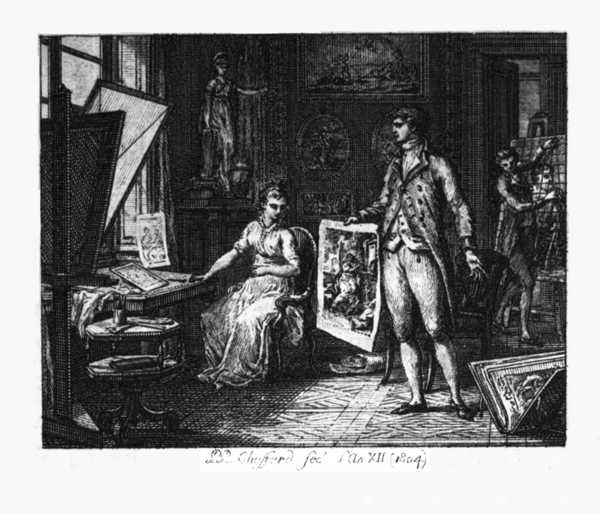
So little is known concerning Pierre-Philippe Choffard himself, that it is difficult to give many facts about his life or even to state with confidence that the year 1730 is that of the great artist’s birth, since Heinecken gives 1729 and other writers mention 1736 as being the date.
Pierre-Philippe’s artistic talent was perceptible at a very early age, for when his father died, leaving wife and child impecunious, we hear that the little boy of ten was in the habit of amusing himself by making floral and conventional designs on the margins of his books, or more probably exercise-books, considering his parents had, evidently, never possessed large means and all literature was somewhat costly in those days. The widow, at that time, suffered business losses which caused her to take young Choffard away from the school he attended, and she wisely placed him in the studio of Dheulland who was an engraver of maps, plans, and other geometrical drawings. No doubt the rising genius found this kind of engraving very wearisome, and to make his work more congenial, he ornamented the borders, in which the maps were framed, with his own unique designs.
The boy is also said to have been aided by lessons from Nicolas Edelinck, who was very old; also from Balechou and Cochin; or, may be, the example of these artists’ works emulated the youth. While yet juvenile Choffard received tuition from Babel, an engraver of decorative ornamentation. Pierre-Philippe’s style and charm of drawing, however, were formed by himself alone, and no master before or since his time has excelled Choffard in the airy atmospheric vitality he imparts into all his magic pencil has chosen to portray, either in the realms of fantasy, in the realities of still life, or even in the rendering of that which his colleagues designed.
The artist must have had as much charm of personality as his achievements had of originality; indeed, it is remarkable to find that whenever his name appears, in memoirs or elsewhere, only good epithets are applied to this self-made artist, who had no social standing and yet was appointed draughtsman and engraver to the Imperial court and to the Spanish throne, whilst the rulers of his native land appear to have given Choffard no post, although he was member of several academies.
When one glances at the views of Prague and the little engravings of English and Scottish towns, it makes one wonder whether he ever travelled abroad, or if Choffard executed these vignettes from other artists’ drawings without stating so. From his “Notice sur l’art de la gravure,” which the draughtsman published a few years before his death, it would appear that he never crossed the Channel, or Choffard would have mentioned his personal experience, instead of giving that of friends, but it cannot be positively asserted that the artist never traversed the French frontier.
Ponce tells us that should some friend of Choffard’s evince difficulty in drawing any portion of a composition in perspective, or if the decoration of a plate proved troublesome and they chanced to ask his advice: “Bring me your work,” he would good naturedly say, “and leave it with me so that I may consider it at leisure.” The friend, on his return, could be positive of finding the difficulty overcome. And was Choffard often known to accept adequate, if any, remuneration for such work? We can draw our own conclusions, knowing his generous character.
His company was enjoyed and appreciated by the most illustrious contemporary painters and engravers, and Wille mentions meeting Choffard in company with de Launay, Lempereur, and Saint-Aubin on one occasion, and another day Choffard, Flipart, Chardin, Roslin, and Vien dined at the same table as Wille. Billiards was a pastime our artist much enjoyed, and on one occasion, when he and his intimate friend Basan and Bervic were staying with Miger at Bagneux, the host’s three guests stayed up all one Saturday night playing billiards. Miger amused himself by celebrating the incident in the following lines:
If a sketching party were arranged, naturally the popular artist was included among its members. Little surprising is it that his popularity increased as steadily as his fame flourished, for this is the state in which an eye-witness describes him arriving at a friend’s country home, with “le petit pain en poche pour le dogue de la porte, les gimblettes pour le petit chien, les bonbons pour les enfants, les fleurs ou le flacon pour la maîtresse de la maison et le gros écu pour les doméstiques.” What artist’s means could stave such a flow of generosity? Is it because the giver always saw the bottom of his purse that his name appears as engraver of mechanical drawings such as those in Berthoud’s “Essai sur l’horlogerie,” and sometimes as the reproducer of brother artist's inferior designs? Yet another cause prevented the greatest “graveur de l’accessoire” from accumulating means—he loved art so passionately that no time, no remuneration, no trouble, no patience, and no difficulties were considered; his work’s success was Choffard’s only thought.
It is interesting to notice how keen the artist was that the plates should be satisfactorily printed on a special kind of paper for an edition of “Les trois femmes.” The long letter relating to this happens to be in existence, and no doubt many another, even more lengthy and detailed, was written by Choffard, who generously dealt out valuable advice to author and publisher. In this instance, as no doubt in all Choffard’s correspondence, the proposals he makes are worded so tactfully as to leave the reader under the impression that the artist is quite willing for his advice to be disregarded. Choffard’s sensitive refinement must indeed have been visible in many ways besides in his art.
Although “enfant des quaies,” as he called himself, yet this self-educated genius had innate refinement and possessed a marvellous power of discrimination and judgement how best to treat delicate passages, intricate subjects, and uninteresting themes, whether the composition had to be confined to the minute dimensions of a tiny fleuron or whether the subject was to occupy a folio page.
“Notice sur l’art de la gravure en France” came from the pen of Choffard. The engraver resented his own art lacking an historian, and therefore became its champion. Had not voluminous books been published on painting and sculpture, yet the sister art had only incidental remarks passed upon it? To fill this void, there appeared in 1804 a little volume written concisely by an eminently capable judge of the talents of past and contemporary engravers. Choffard shows remarkable fairness in dealing with draughtsmen of different styles, of many lands, and of varied temperaments, and is broad-minded in all matters where our countrymen are not concerned. It is only natural that a Frenchman should look on his British neighbours with a frown in the eventful year when Napoleon was elected emperor! Great as were Choffard’s anti-British prejudices, it must be admitted that they did not prevent him from praising the talent of Ryland, and of mentioning the names of many other British engravers. Now and again, in perusing the pages of the little book, one alights on a date which is at variance with our modern historians’ statements, a fact that is hardly worthy of mention, considering exactitude troubled eighteenth-century writers far less than it does contemporary biographers in these scientific days.
The charming vignette Choffard executed for his volume is said, by some, to represent the artist, as a young man, in his studio and would suffice to make the book live and be collected, whatever may be its literary merits or demerits. It is curious to note that a host of the artist’s illustrations are contained in works wholly unworthy of Choffard’s great results, or else they illustrate literature that is very little read in modern times.
Pierre-Philippe Choffard was an exceptionally prolific artist, and, as has been said before, loved his work passionately. An hour before his death he still had his thoughts bent on art and sent to fetch paper on which to draw a reduction of a picture by Legrand. The dying artist had formed the resolution to write a more extensive work than his first successful “Notice” on the art of engraving, and this reduced plate would have been contained within its pages had fate been kinder.
On the seventh day of the month of March in the year 1809 the world lost its greatest “maître ornemaniste” by the death of Pierre-Philippe Choffard.
The eighteenth century was a period when letter-writing, diaries, and memoirs were greatly in vogue; yet rarely on these milestones of the past appears the name of Choffard, proving how uneventful must have been his life. Notwithstanding this probable fact, we cannot but regret that our artist did not leave his life impressions, which would have been full of interest, since he met and associated with all the leading talent of his day.
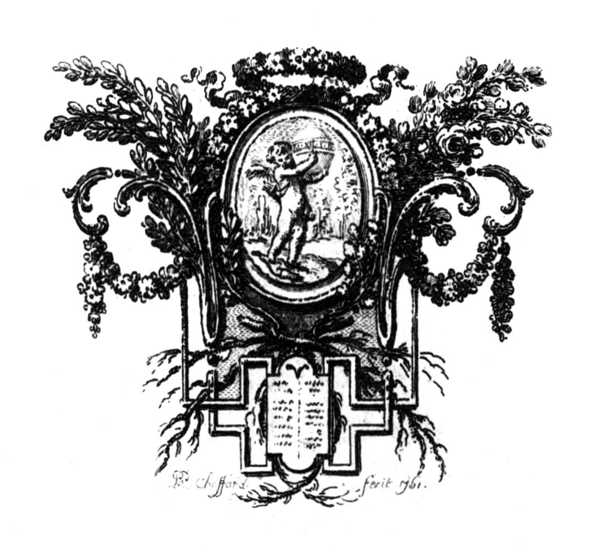
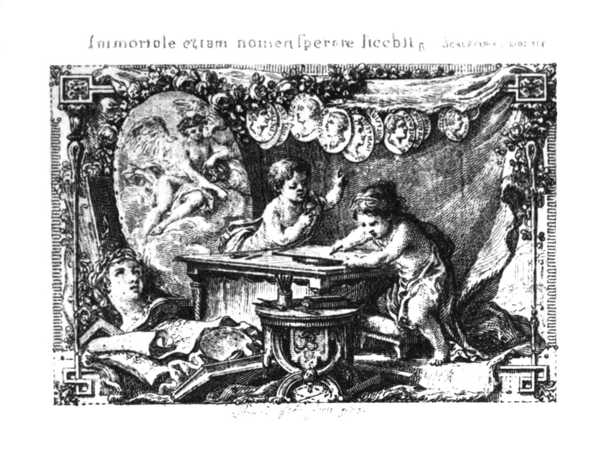
The greatest and most permanent monuments of fame that any man can raise to his own memory are those he builds for himself. The colossal masterpiece that stands outlined against the horizon of Choffard’s career is his etchings for “Les Métamorphoses d’Ovide.” These thirty-seven little pictures that his needle bequeathed to posterity can best proclaim their own praises; five of them are from drawings by Monnet, the other plates are entirely by Choffard. It would be an impossible and a useless task for me to attempt to do Choffard’s masterpieces justice in words, for the artist’s inventive power is so remarkable, the delicacy of his touch so fairy-like, his compositions so delightful to the eye and pleasing to our sense of balance, and the marvellous brilliancy and effect of sunshine are so exquisite, that not the connoisseur alone discerns Choffard’s genius, but even the uninitiated pause in deep admiration before his superb vignettes.
Unfortunately much of Choffard’s finest work is other than the decoration of literature, and can, therefore, find no place within the space of these few pages. The draughtsman was so fond of his art that whatever purpose his drawing was to serve, all his efforts were expended on it; thus we find some of his finest pieces are trade-cards, ball-tickets, designs commemorating events such as marriages, visiting-cards, little screens, diplomas and medals, and it seems very probable that in his youth, the “enfant des quais” executed much that we, nowadays, are unable to affirm is from his hand, although in his style, for it is modestly left unsigned, and it may here be noted that Arrivet often approached Choffard in his style of designing floral borders.
Jean-Georges Wille was amused as he entered in his journal: “Monseigneur le Prince de Nassau-Saarbrück proposed for me to engrave his arms; it made me laugh; but I excused myself by proposing M. Choffard who is good at ornamentation.” If we look at book-plates of Choffard’s creation, or at the little dedication-plate to the Comte d’Artois in de Piis’ “Chansons nouvelles,” one is able to realize how just the great portrait engraver’s recommendation was. The reproduction here given of this small dedication-page gives but a slight idea of the original in a fine state, for no reproduction can possibly render justice to Choffard’s etched or engraved work. It is astonishing, even with the originals, what an extraordinary difference it makes to the picture, whether the proof is brilliant or a late impression, so is it surprising that mechanical reproductions give but a notion of that which they represent, where brilliancy and delicacy of touch are of infinite value. Every collector ought to be especially careful in avoiding proofs printed from worn or retouched plates, for they do not produce the artistic harmonies the draughtsman strove for and succeeded in achieving.
The majority of Choffard’s book-illustrations consists of designs by other artists which he has reproduced, but as Choffard was a prolific draughtsman, posterity nevertheless possesses a number of volumes wherein design and engraving are both of his own execution. In etching or engraving, Choffard’s personal, brilliant touch is almost invariably apparent, whether in reproducing the work of another, or in his own compositions; thus other artists’ works had their beauty enhanced by their translator, whereas in the few cases where Choffard left the engraving of his compositions to a strange hand, their character and vitality were weakened. Is this because Choffard was the best engraver of his day? No, several there are who could claim this place with equal right. A drawing by Choffard which is also his own etching, and the identical design if reproduced or only terminated by another, would show the same difference as there is between a letter written by hand or by a typewriter. In the one instance we only see the meaning which numberless lines depict, in the other case each line conveys a message, every curve speaks, no dot is meaningless, every touch is expressive of the character and mood of the individual. It must not be concluded from these remarks that Choffard maintained this exalted standard of work uninterruptedly during his long career, for occasionally, especially towards its close, one encounters plates signed “P. P. Choffard” and yet they do not bear that seal of charm and freshness which we are wont to expect from this genius. Pierre-Philippe Choffard, however, has not, like some artists, a given period during which he executed mediocre plates; in fact, none of his work could rightfully be dubbed indifferent or bad.
On the whole this draughtsman’s illustrations are of medium dimensions, but the fine tail-piece to the “Voyage pittoresque de la Grèce” and the fleuron on the dedication-page of the “Galerie du Palais-royale” are both of them good examples of his large original work. The latter, although etched by Choffard, is terminated by Guttenberg. Other lovely examples of this kind are the fleuron for the dedication to the Queen in Saint-Non’s “Voyage pittoresque des Royaumes de Naples et de la Sicile,” and the two tail-pieces Choffard also executed for this book. The remarkable one that represents Messina before the earthquake that took place there in 1783, pictures the view of the town on a torn sheet of paper, and through the rent is seen a tree, a branch of which protrudes and overlaps a part of the picture; while a smoking torch is placed below the view, so as to give the tail-piece the appearance of a kind of allegorical prediction of the catastrophe that was to befall the ill-fated city. This composition is an exceptional piece of artistic ingenuity, invention, and skill in placing everything in the most advantageous manner, while yet giving each item its true colour value; these qualities, however, are salient in all Choffard’s good work.
Unlike Marillier and Eisen, Choffard’s drawings, for the most part, are not wonderfully minutely treated, for the inventor was accustomed to transferring his own design on to the copper and therefore frequently dispensed with great finish in his drawings. Many of Choffard’s illustrations are pure etchings, such as those in the 1762 edition of La Fontaine’s “Contes et nouvelles en vers,” but like these, his pure etchings are usually from his own sketches. Even those drawings of Choffard which have been engraved by a stranger have, in many cases, been preliminarily etched on the copper-plate by Choffard himself.
There are so many angles from which the various aspects of Choffard’s career may be gauged, that it would be interesting to speculate as to the place his talents would occupy to-day, if Choffard lived now instead of being our ancestors’ contemporary. Some may think that his light would not shine so brightly in the twentieth century, since there is no Eisen or other great illustrator with whom to intermix his plates and thus help to form a contrast of exquisite illustration, each enhancing the other draughtsman’s style. This is an error. Were such a master as Choffard to exist in these materialistic days, he would be admired ten-fold more than artists now praise the talent of this draughtsman of bygone times; no Moreau, Cochin, Eisen, Marillier, or Gaucher now live to dispute the laurels with him, and Choffard would stand alone, not only the recognized “maître ornemaniste” but also the champion vignettiste, illustrator, designer, and engraver of our days.
Even during the eighteenth century he was marked out as a fine engraver of illustrations, and he likewise successfully engraved estampes and portraits. The likeness of La Rochefoucauld serves as an excellent example of Choffard’s skill in handling the burin, and this small portrait alone, would suffice to place him equal with that king of miniature portrait engraving—Gaucher. The “Maximes et réfléxions morales,” to which this plate forms a frontispiece, bears the date 1778 on the title-page, whereas La Rochefoucauld’s portrait is dated a year later, by Choffard. A post-dated illustration is a circumstance frequently encountered in French books of the eighteenth century, and it is often difficult to decide whether the volume itself was published later than is stated or if the plates were issued for insertion in the book after its publication. Both methods are known to have been practised, and it is of little consequence to collectors whether the illustrations were or were not contained in the book at the time of issue, considering certain works are deemed incomplete if they do not comprise the post-dated plates which properly belong to that particular work. There are also portraits that were published separately and yet are usually found in books; connoisseurs do not in these cases regard certain volumes as complete when such a portrait, or more, are absent, because it has been the custom, among collectors, to add this special picture, or pictures, to the copy of a work to which the plates apply, when they were obtainable, and thus the best-known copies of such books contain them. This is the case with Président Hénault’s “Histoire de France.”
It may also be remarked that illustrations executed for one book were often used for several other works. Those plates that found favour in the sight of connoisseurs were sometimes copied, or worn plates were retouched and issued as originals; therefore the collector of to-day must be very cautious lest he buys a book on old paper with plates professing to be by the artist whose name they bear, but which are nevertheless from faked plates or are forgeries. Another peculiarity of some books of that period, is the way in which they were issued; an edition was divided between several publishers either because they all desired to have a hand in the issue or perhaps to lessen the risks. This accounts for the reason why some books appear under the names of different publishers, although the volumes themselves are identical. The 1767-1771 edition of “Les Métamorphoses d’Ovide” appeared under the names of five different publishers, each placing his own name in the particular copies for which he subscribed. Furthermore it would appear that at times, a publisher would place a title-page in his copies with as marked a difference as that of altering the name of the work itself. For instance “Les jeux de la petite Thalie,” by Gravelot, also appeared under the title of “Almanach utile et agréable de la loterie de l’école royale militaire pour l’année 1759 et 1760” with the frontispiece changed.
Eaux-fortes and proofs before letters of Choffard’s plates exist in almost every instance, and they command a much greater price than impressions after letters. Naturally first proofs are usually far more brilliant than later ones and are deservedly prized by collectors. Nevertheless a prohibitive value is frequently placed on certain rare states and on scarce eaux-fortes, which makes one realize how true Seymour Haden’s remark is, when applied to this case: “First comes the biographer and cataloguer with wearisome precision to describe different states of a plate and then the dealer to persuade that the first two of these ‘states’ are worth three times more money than the perfected plate; a grave misconception.” From the artist’s point of view, undoubtedly, this is an absurd misconception, but a collector or a student naturally regards the various stages of the masterpiece’s progress as an interesting adjunct to the enjoyment and appreciation of the finished work.
The book known as the “Fermiers généraux” edition of the “Contes et nouvelles en vers,” by La Fontaine, is justly regarded as containing some of the most beautiful examples of Choffard’s work, for every little picture, so different in theme, is a revelation of the artist’s extraordinary powers. There is tender love for his art in every stroke that caressingly models the allegorical figures whose graceful contours repose on transparent clouds, also in the floral designs, minute genre pictures bordered by drapery and flowers, and in a medal with the artist’s portrait amidst garlands and clouds and a multitude of other picturesque combinations that are contained within the two volumes. But perhaps the most ingenious little vignettes are those that treat of commonplace things, of vulgar, raw substances such as a piece of meat or dead fish in a net. The subjects sound almost repulsive; there are not even the beautiful hues of the rainbow trout to relieve the coarseness and crudeness of the subject! It is in cases such as these that Choffard’s unique talents are forcibly apparent, for instantly one admires the little pictures, regardless of the subject which is represented so attractively as to form an artistic composition.
“Le jugement de Paris” and the two editions of “Les Saisons” also contain well-known illustrations by Choffard. These latter are usually considered to rank among his “chef-d’œuvres,” although it seems doubtful whether they equal his real masterpieces. They appear to represent the subjects in cameo form, whereas the little medallions just fail to give that effect, thus leaving us to decide for ourselves the meaning of the deep shadow outlining the small figures.
The words “plan of London” convey no idea of an artistic illustration, and yet Choffard executed a delightful vignette with the metropolis’ highways, streets, houses, and river distinctly mapped out in the centre of an ornamental frame. Berthoud was fortunate when he obtained a charming fleuron by Choffard for his “Histoire de la mesure du temps par les horloges,” for who but the “maître ornemaniste” would have succeeded in forming a delightful “ensemble” with rectangular clocks and scientific instruments?
The little battle scenes which illustrate “Préjugés militaires” are exquisitely composed, and are excellent examples of the delicacy and depth with which Choffard etched. His talents in this line are also exceptionally remarkable in the head-piece containing Basan’s engraved portrait, which forms the centre of the composition, on each side of which are the great publisher’s studio and study.
In the pages of “L’histoire de la maison de Bourbon” Choffard’s genius shines forth with brilliant vigour. Each tail-piece, so similar in subject yet very different in design, is an allegorical composition aptly illustrating the chapter it terminates. When these fleurons and tail-pieces are in proof and the complete impression of the copper-plate is shown, there are words engraved “à la pointe” on the extreme top edge of the plate. In a few cases they only note the volume and page in the book that the picture is to occupy, but above the proof of the tail-piece here reproduced are the words:
“Toe. V. Page 354 La Perfidie entoure de pieges les Armes de France et de Navarre, et elle s’efforce d’eloigner Bourbon du Trone, agité de fureur, le fanatisme employe contre ce Prince le fer, et le poison.” (In the original, as quoted, many accents are omitted.)
There appear to be no proofs in an earlier state than with these letters “à la pointe,” or if any exist, they are practically unique.
One of the five fleurons by Choffard for Rousseau’s works is reproduced in this book, and is here followed by the same illustration with the figure draped. This latter is a later state and was never published nor is it cited in any catalogue. Plates in the early state are frequently encountered with points differing from the final ones, due, no doubt, to the artist, author, or publisher wishing for some alteration in the design; these differences are at times very perceptible and at others hardly noticeable. It also sometimes happens that the earlier state was selected for publication, as in this case.
Could there be any more appropriate conclusion to this chapter than Baron Roger Portalis’ just eulogy on Choffard’s art?
“Son exécution est brillante et précieuse, son burin à la fois ferme, transparent et léger; s’il a rarement été chargé de la composition des principaux sujets dans les grandes illustrations des ouvrages de son temps, et si sa collaboration n’a guère été que le complément des travaux des Eisen, des Moreau, des Cochin, des Monnet, il faut dire que le complément a singulièrement fait valoir et quelquefois fait pâlir l’œuvre principale. Du reste, il a souvent interprété ses grands collaborateurs avec un art, une fidélité et une richesse de tons dont ils dû être fort satisfaits, et on peut répéter de lui ce beau titre qui lui a été donné jadis de graveur coloriste.” Those who to-day look upon Choffard’s work in an unprejudiced light cannot do otherwise than feel the force of the above words and re-echo them from their hearts.
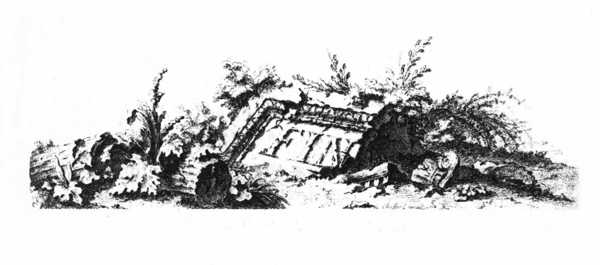
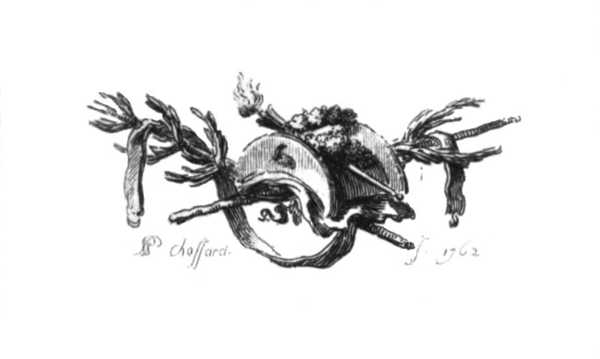
A ELLE. Six Romances, avec accompagnement de piano. A Paris, chez Pleyel, prix 6 f. 4to. The ornamental title-page is engraved by Choffard after J. Guérin.
ALMANACH DU CHASSEUR (par Goury de Changrand). Paris, Pissot, 1772 and 1773, 12mo. A frontispiece by Choffard.
AMUSEMENTS D’UN CONVALESCENT, dédiés à ses amis. Paris, 1761, 8vo. A vignette on the title-page by Gravelot, engraved by Choffard.
ANVILLE (D’). Troisième Partie de la Carte d’Europe, contenant le Midi de la Russie, la Pologne et la Hongrie, la Turquie, etc. Publiée sous les auspices de Monseigneur Louis-Philippe Duc d’Orléans, etc. 1759. One cartouche drawn by Gravelot, engraved by Choffard.
D’Anville was Gravelot’s elder brother.
ARGENVILLE (Dezallier d’). Abrégé de la Vie des plus Fameux Peintres, etc. Paris, de Bure, 1745, 2 vols., 4to.
SUPPLÉMENT À L’ABRÉGÉ, etc. Paris, de Bure, 1752, 4to. In all 3 vols. A frontispiece, 3 vignettes, one tail-piece, and 254 portraits or ornamental frames for portraits. The tail-piece is by Choffard.
ARIOSTE. Orlando Furioso di Ludovico Ariosto. Birmingham, Baskerville, 1773, 4 vols., large 8vo. A portrait and 46 illustrations. One plate is engraved by Choffard after Monnet.
A fine edition. Some very scarce copies contain plates before letters, with the exception of those engraved by Bartolozzi. 100 large paper copies were issued 4to size.
ARSACE ET ISMÉNIE, Histoire Orientale. Royal 8vo. The title-page is designed by Choffard and Le Mire engraved it.
ARTE Y PUNTUAL EXPLICACION DEL MODO DE TOCAR EL VIOLIN, etc., compuesto por D. Joseph Herrado ... quien le dedica al Excmo. Sr Dn Francisco Ponce de Leon ... La Mca y Ltra gravada por Melle Vendome.
A title-page, on one copy of which are written the words “Joannes a cruce faciebat Parisiis 1759,” “P. P. Choffard ornamenta.”
ATLAS TOPOGRAPHIQUE DES ENVIRONS DE PARIS, dédiés et présenté au Roy par son très-humble et très-obéissant serviteur ... Lattré. A decorative title-page by Choffard.
BACHELIER. Collection de Cul [sic] de Lampes [sic] et Fleurons, inventés et dessinés par Mr. Bachelier, peintre du Roy, tirée de la grande edition in-folio des Fables de la Fontaine, et gravés par P. P. Choffard. Distribués en quatre suites; Avec privilege du Roy. Ier. suite. A Paris chés [sic] la Ve. Chereau rue St. Jacques au 2 Pilliers d’Or. Royal 8vo. A fleuron on the title-page and 5 plates engraved by Choffard after Bachelier. There are 2 or 3 separate designs on several of the sheets.
This suite and the next one mentioned, are not the actual illustrations that appear in the folio “La Fontaine,” although the title states so. Those contained in the 1755-1759 edition are not from copper-plates, but are wood-engravings, executed by Papillon, for the most part. These woodcuts are evidently copies of the designs which Choffard engraved after Bachelier.
BACHELIER. 2me. Suitte [sic] de Culs de Lampes [sic] et Fleurons, inventés et dessinés par Mr. Bachelier Ptre. du Roy, tirée de la grande edition in-folio des Fables de la Fontaine, et gravés par P. P. Choffard. Avec privilége du Roy. A Paris, chéz la Ve. Chereau rue St. Jacques aux 2 Pilliers d’Or. Royal 8vo. A fleuron on the title-page and 5 plates by Bachelier engraved by Choffard. There are 2 separate designs on some of the sheets.
The same remarks apply to this suite as well as to the last.
BASAN. Recueil d’Estampes Gravées d’après les Tableaux du Cabinet de Monseigneur le Duc de Choiseul, par les soins du sieur Basan. A Paris, chés [sic] l’Auteur, rue et hotel serpente, 1771, 4to. A title-page, dedication-page, one portrait, and 128 plates. The title-page is by Choffard.
The numbering of the plates goes up to number 123; the figures 68, 69, 76, 78, and 101 are repeated; these duplicate numbers have an asterisk against them.
The Duc de Choiseul sold his beautiful collection of pictures after falling into disgrace at court in 1770.
BASAN. Catalogue Raisonné des Differens Objets de Curiosité dans les Sciences et dans les Arts qui composoient le Cabinet de feu M. Mariette, etc., par F. Basan, graveur. A Paris, 1775, 8vo. A decorative title-page, a frontispiece, and 4 etchings. The fine frontispiece is by Cochin, engraved by Choffard, and exists before letters.
Only 12 copies of this book were printed on holland paper.
BASAN. Catalogue d’une Belle Collection de Dessins Italiens, Flamands, Holandais et François, etc., le tout rassemblé avec soins et dépenses par M. Neyman, amateur à Amsterdam, etc., par Fr. Basan. Le présent catalogue est orné d’un frontispice par le sieur Choffard, et de XIV. [sic, read 19] estampes gravées à l’eau-forte par Weisbrodt, Duplessi-Bertaux et Le Veau, d’après des dessins capitaux d’Adrien van Velde, etc. Paris, Basan et Prault, 1776, 8vo. Decorative title-page by Choffard.
BASAN. Collection de cent vingt estampes gravées d’après les Tableaux et Dessins qui composoient le Cabinet de M. Poullain receveur général des domaines du Roi, décédé en 1780, etc., exécutées sous la direction du sieur Fr. Basan, graveur, etc. Paris, Basan et Poignant, 1781, 4to. A fleuron on the dedication-page by Choffard, an ornamented title-page and illustrations by other artists.
The illustrated title-page used in the “Catalogue Neyman” is repeated in this volume, with the title altered to suit the book. The artist’s signature without the date is on this plate, whereas in the “Catalogue Neyman” the plate is dated.
BASAN. Dictionnaire des Graveurs Anciens et Modernes, depuis l’origine de la Gravure, par F. Basan, graveur; seconde édition mise par ordre alphabétique, considérablement augmentée et ornée de cinquante estampes par différents artistes célébres, ou sans aucune au gré de l’amateur. Paris, chez l’auteur, Cuchet, Prault, 1789, 2 vols., 8vo. 3 pretty head-pieces by Choffard: one on the dedication-page, another on the first page of the catalogue in volume i; the third is in the second volume and is a little masterpiece. This latter was reprinted in Regnault’s catalogue of Basan’s collection; it represents Basan’s study on one side and his studio on the other. In the centre of the composition, which is dated 1790, Choffard has placed a framed portrait of his friend Basan. These 3 vignettes exist in proofs before text and in various other states.
Most of the other illustrations are borrowed from different works.
The vignette containing Basan’s portrait is dated 1790, the other head-pieces are dated 1789. Evidently the second volume of the book (if not both parts) did not appear until 1790, considering the head-piece thus dated is printed in the text and would therefore not have been added after the volume’s issue.
This little portrait of Basan was used again for the re-issue of the same book—Paris, Blaise, 1809.
BELLIN. Essai Géographique sur les Isles Britanniques, etc., pour le service des vaisseaux du Roi, etc., par M. Bellin, etc. A Paris, de l’imprimerie de Didot, 1757, 4to. An engraved title-page, a fleuron on the title, one vignette, 11 head-pieces, 22 tail-pieces, and 5 maps.
The little views and plans by Choffard are charming and are far superior to the other illustrations in this volume. The vignette representing “Plan de Londres” and 4 tail-pieces are signed by Choffard, the frames of several of the other tail-pieces and the little view of Windsor, which forms a cul-de-lampe, may also be attributed to him. Choffard’s border for the title-page is used for the same purpose in “Description géographique des débouquemens de Saint Domingue” by the same author.
BELLIN. Description Géographique des Isles Antilles, possédées par les anglais, etc. A Paris, de l’Imprimerie de Didot, 1758, 4to. An engraved title-page, 12 maps, and 10 head-pieces. The frame for the title-page and one head-piece are by Choffard.
BELLIN. Déscription Géographique de la Guyane, etc. Dressées au Dépost des Cartes et Plans de la Marine par ordre de M. le Duc de Choiseul, Colonel Général des Suisses et Grisons, Ministre de la Guerre et de la Marine, etc. A Paris, de l’imprimerie de Didot, 1763, 4to. A frame on the title-page, a head-piece to the “avertissement,” one head-piece and 10 plates representing natives, animals, plants, etc., and 20 maps or plans.
The frame round the title is signed “Croisey Sc.,” and is similar to that in “Description géographique des isles Antilles,” which is signed “P. P. Choffard fecit 1758.” “Déscription géographique de la Guyane” has the same title-border as the other book, only it is reversed and has a slight alteration in the top of the design. The head-piece to the “avertissement” is also the same as that in “Description géographique des isles Antilles,” in which book it is signed “P. P. Choffard fecit 1758,” whereas in “Déscription géographique de la Guyane” it is signed “P. R. Rameau fecit 1762,” and is reversed; it is also a little larger, owing to the fact that there is slightly more space between the vignette and the border, and a muzzle of a cannon, etc., are added. Probably Rameau copied Choffard’s plate. This head-piece is also in “Description géographique du Golfe de Venise et de la Morée.”
BELLIN. Description Géographique et Historique de l’isle de Corse, etc., par le Sieur Bellin, ingénieur de la Marine. A Paris, de l’imprimerie de Didot, 1769, 4to. A head-piece, 2 ornamental borders, and many maps.
The head-piece is by Choffard and appears in “Description géographique des débouquemens qui sont au nord de l’isle de Saint Domingue” and in “Description géographique du Golfe de Venise et de la Morée.”
BERQUIN. Œuvres Complètes de Berquin, nouvelle édition rangée dans un meilleur ordre. Paris, Renouard, an XI. [1803]. 17 vols., crown 8vo. 204 illustrations. The decorative title-page to the “Idylles” is drawn by Monsiau and engraved by Choffard.
Published on vellum paper; 3 copies are mentioned as being printed on pink paper.
BERTHOUD (Ferdinand). L’Art de Conduire et de Régler les Pendules et les Montres, etc. A Paris, chez l’auteur, chez Michel Lambert, 1759, 12mo. 4 engravings of mechanical plates by Choffard.
BERTHOUD (Ferdinand). Essai sur l’Horlogerie. Paris, 1763, 2 vols., 4to. 38 engravings of mechanical drawings by Choffard.
BERTHOUD (Ferdinand). Traité des Horloges Marines, etc. A Paris, chez J. B. G. Musier fils, libraire, 1773, 4to. A fleuron on the title-page by Choffard, a vignette with Louis XV’s portrait above the dedication by Cochin, engraved by Choffard and 27 mechanical drawings engraved by Choffard.
The fleuron also appears on the title-pages of Eclaircissemens sur l'Invention ... des Nouvelles Machines Proposées en France, pour la Détermination des Longitudes en Mer par la Mesure du Temps, etc. A Paris, chez J. B. G. Musier fils, libraire, 1773, 4to, and Traité des Montres à Longitudes, etc. A Paris, de l'Imprimerie de Ph.-D. Pierres, Premier imprimeur du Roi, 1792, 4to.
BERTHOUD (Ferdinand). De la Mesure du Temps par les Horloges dans l’Usage Civil, etc. A Paris, de l’imprimerie de A.-J. Baudelot & J.-M. Eberhart, Fructidor, l’An V. de la République (1797 vieux style), 4to. 9 mechanical drawings engraved by Choffard.
BERTHOUD (Ferdinand). Histoire de la Mesure du Temps par les Horloges, par Ferdinand Berthoud, Mechanicien de la Marine, etc. A Paris, de l’Imprimerie de la République, an X (1802 v. s.), 2 vols., 4to. A fleuron repeated on the title-page of each volume and many diagrams and plates.
The fleuron, which is by Choffard, represents an ornamental slab on which clocks, a gyroscope, and other scientific instruments are placed. The little vignette is one of the numerous examples of the artist’s skill in rendering inartistic subjects pleasing to the eye. Not only has he placed the various instruments in foreshortened positions and broken their stiff outlines by allowing books and scrolls to lie about in agreeable disorder, but a charming little view of the Place Carousel forms the background, thus completing the picture.
BLIN DE SAINMORE. Lettre de Sapho à Phaon, précédée d’une épître à Rosine, etc., par M. Blin de Sainmore. Paris, Sébastien Jorry, 1767, 8vo. 3 illustrations, including a tail-piece by Choffard.
The latter, touched up and dated 1801, appears in Basan’s “Dictionnaire des Graveurs.” This book, together with other opuscules of Blin de Sainmore, was republished under the title of “Héroïdes” or “Lettres en vers,” Paris, S. Jorry, 1767, 5 vols., 8vo, and contains the same plates. There are some holland paper copies.
BOCCACE. Il Decamerone di M. Giovanni Boccaccio. Londra (Paris), 1757, 5 vols., 8vo. Profusely illustrated. There are 4 tail-pieces Choffard engraved after Gravelot.
The first proofs are marked with a “paraphe” on the lower part of the back of each plate and it looks like a small script monogram. The volumes containing these are most sought after. All copies are on holland paper. There exist proofs before the artists’ names and in various other states. The pictures in the Italian edition are accepted as the first impressions from the plates. There are, however, copies of the French edition which contain proofs with the “paraphe” and they were placed in the volumes at the time of issue.
The French edition of this book, “Le Décameron de Jean Boccace, traduit par Le Maçon,” Londres (Paris), 1757, 5 vols., 8vo, contains the same plates and tail-pieces as in the Italian edition. This translation, published by the same editors as those of the Italian edition, is much sought after, although the proofs of the full-page plates and especially of the tail-pieces, are not as fine. There was one issue on large paper, which is less good than the small paper copies. Some collectors put full-page plates of the Italian edition into their copy of the French edition; nevertheless, they cannot hide the inferiority of the tail-pieces. These latter are even repeated in several parts of the book and are not put at the same places as in the original edition. Note that the full-page plate which belongs to the first “Nouvelle” of the eighth “Journée” is different in the French edition from that in the Italian one.
There are several re-issues of this work, which are very inferior to that of 1757.
BOCCACE. Estampes Galantes des Contes du Boccace. A Londres, 1759, 4to. A title-frontispiece and 20 plates designed by Gravelot. Choffard engraved the title-page.
BOCCHERINI (Luigi). Douze Nouveaux Quintetti; pour deux violons, deux violoncelles et alto, par Luigi Boccherini, etc., œuvre 37, Prix 9 fr. A Paris, chez Ignace Pleyel, etc., large 4to. Title-page by Choffard.
BRISEUX. Traité du Beau Essentiel dans les Arts, appliqué particulièrement à l’Architecture, etc., par le sieur C. E. Briseux, architecte. Paris, chez l’auteur et chez Chereau, 1752, 2 vols., 4to. 6 tail-pieces by Choffard and 2 architectural drawings engraved by the same artist. One tail and a head-piece are in Choffard’s style, but are unsigned. This draughtsman may likewise have engraved some of the architectural plates that bear no signature. Also many plates by other artists.
A sumptuous book with the text engraved.
BUSSY-RABUTIN. Histoire Amoureuse des Gaules. (Paris), 1754, 5 vols., 12mo. 5 engraved title-pages designed by Choffard; 2 of them are engraved by Legrand.
CABINET DES FÉES, ou collection choisie des contes de fées et autres contes merveilleux, ornées de figures. Genève, Barde, Manget et Cie, et Paris, 1785-1789. 41 vols., 8vo. 120 plates by Marillier, of which Choffard engraved one.
Since there are 3 plates in each volume the book ought to contain 123 illustrations; but it must be noted that volume 37 has no pictures. There are 2 plates which are missing in most copies. The one belongs to “Barbe-Bleue,” and has “Dans ce moment on heurta si fort à la porte” inscribed on it, and the other bears the words “Le Petit Poucet s’étant approché de l’Ogre.” These two plates appear to have been replaced by the two others that illustrate these “contes” in all the ordinary copies of the book. The plates in the 12mo edition are later impressions than those in the 8vo. one.
The pictures are very commonly found bound without the text, and collectors appear to prefer them in this form.
CARTES ET TABLES DE LA GÉOGRAPHIE PHYSIQUE OU NATURELLE, cet ouvrage approuvé et publié sous le privge. de l’Ac. se trouve à Paris sur le quai de l’Horloge. A frame by Choffard.
CATALOGUE DES CHEVALIERS, COMMANDEURS ET OFFICIERS DE L’ORDRE DU SAINT-ESPRIT, avec leurs noms et qualité depuis l’institution jusqu’à présent. Paris, de l’imprimerie de Ballard, 1760, folio.
The publishers appear to have issued this book, in 1760, with a varying number of illustrations.
The following is the description of the illustrations in a very fine copy: a frontispiece by Boucher, engraved by L. Cars, a fleuron on the title-page, 1 head-piece, 5 head-pieces with portraits of French kings, 16 tail-pieces, some being repetitions of the same designs, and 5 ornamental letters. All the illustrations, excepting the frontispiece, bear the initials “H. G.” (Hubert Gravelot) and “L. C.” (L. Cars). Choffard, however, engraved them under Cars’ direction, in spite of them not being signed by Choffard, who likewise etched the two ornamental letters H and the three Ls, and Choffard designed the very small fleurons that are contained within the frame of these letters, which are charming.
CATALOGUE DES PLANCHES GRAVÉES QUI COMPOSENT LE FONDS DE BASAN. 1805.
This book contains a charming oblong vignette by Choffard, representing Basan’s gallery, in which “amateurs” are sitting and strolling.
CAZOTTE. Œuvres Badines et Morales de M.... Amsterdam et Paris, chez Esprit, 1776, 2 vols., 8vo. 2 plates by Cochin, engraved by Choffard and Prévost.
CHANGRAN (De). Manuel du Chasseur, etc., par M. de Changran. A Paris, chez Saugrain et Lamy, libraires, 1780, 12mo. An etched title-page by Choffard.
CHARRIÈRE (Mme. de). Les Trois Femmes, par Mme. de Charrière, auteur des lettres écrites de Lausanne, etc. Paris, Nepveu, libraire, passage des Panoramas 26, 1809, 8vo. A frontispiece and 6 plates by Legrand. The frontispiece and 3 illustrations are etched by Duplessis-Bertaux and finished by Choffard.
CHATEAUBRIAND. Atala-René, par Fr. Aug. de Chateaubriand. A Paris, chez Le Normant, 1805, 12mo. 6 plates by Barth. Garnier, 3 of which are engraved by Choffard.
This is the original edition and exists on vellum paper with plates before letters. There are also large paper copies.
CHÉREAU. Diversi Trofei de B. Bossi et P. P. Choffard. 2 books, each containing 6 designs.
Chéreau published them, therefore they appear under his name.
MM. Portalis and Béraldi say that, similar to the suite next mentioned, there is some manipulation on the part of the publisher. No doubt these plates, which are very poor impressions, are either copies of the originals by Choffard or are from faked plates. ·
CHÉREAU. Six books of “cartouches” by Choffard were published by Chéreau. They ought to be mentioned, though they are of very minor importance, considering the six plates, that each book contains, are only copies of the “cartouches” which Choffard executed for Robert de Vaugondy’s atlas and for other maps.
CHOFFARD. Livre d’Écussons et Cartels, dessinés par P. P. Choffard. A Paris, rue St. Jacques, aux deux pilliers d’or. 7 oblong plates, containing 10 designs.
CHOFFARD. Notice Historique sur l’Art de la Gravure en France, par P. P. Ch..., dessinateur et graveur, ci-devant de plusieurs Académies royales, membre de l’Athénée des Arts. A Paris, chez Pichard, libraire, Pélicier, libraire, an XII—1804. 8vo.
The pretty head-piece etched by the author is said, by some, to represent Choffard, as a young man, in his studio.
Some copies of this book bear the name of “Richard” as publisher.
CHOISEUL-GOUFFIER (Comte de). Voyage Pittoresque de la Grèce. Paris, 1782-1809, 2 vols., folio. A portrait, 1 large fleuron on the title-page, 12 large fleurons and tail-pieces, and 89 plates.
One head-piece and a tail-piece, both very fine and belonging to the first chapter, are engraved by Choffard; the head-piece is after Monnet and the tail-piece is designed and reproduced by Choffard.
The publication of this sumptuous work was interrupted by the Revolution and the second volume appeared in separate parts between the years 1809 and 1825. The first volume is the only one that is collected, the second being very inferior.
CORNEILLE. Théâtre de P. Corneille, etc. Nouvelle édition augmentée. Genève (Berlin), 1774, 8 vols., 4to.
The 35 illustrations found in “Théâtre de Pierre Corneille, avec commentaires (par Voltaire),” etc. (Genève), 1764, 12 vols., 8vo, are republished framed in this edition. Gravelot designed these frames, and the one round Corneille’s portrait is engraved by Choffard.
COUCHÉ. Galerie du Palais-Royal, gravée d’après les tableaux des différentes écoles qui la composent, etc. Paris, J. Couché et Bouilliard, 1786-1808, 3 vols., large folio. A fleuron on the dedication-page and 355 illustrations.
The fine design on the dedication-page is by Choffard, who also etched it, the engraving work upon the plate being done by Guttenberg. A certain number of copies were printed on “colombier” paper, with plates before letters (with the titles printed separately on tissue paper) and 12 copies on “vélin jésus” paper, likewise containing plates before letters.
The pictures of the Palais-Royal were dispersed during the Revolution and sold in England.
CUVILLIÉS. Cahiers de Projets d’Architectures. Serie C.
Architectural plans, etc., and a cartouche enclosing the dedication to “Son Altesse S. E. de Bavière.”
DELILLE (L’Abbé). Les Jardins, poème, par Jacques Delille, nouvelle édition considérablement augmentée. Paris, Levrault frères, an IX—1801. 12mo. 4 plates by Monsiau, 2 of which Choffard has engraved. Published on ordinary and on vellum paper.
Plates before letters exist.
DÉSORMEAUX. Histoire de la Maison de Bourbon. Paris, imprimerie royale, 1779-1788, 5 vols., 4to. A frontispiece, a decorative dedication-page, 5 fleurons on the title-pages, 14 framed portraits, 21 vignettes, and 21 tail-pieces.
A magnificently illustrated work.
The beautiful tail-pieces, which are all by Choffard, show how clever this artist is in avoiding similarity even when the subjects seem to necessitate repetition, since similar trophies are introduced into nearly every tail-piece without any positive resemblance, showing great ingenuity on the part of the artist.
Each portrait is in a differently decorated frame designed by Choffard, who also etched and possibly engraved them. These portraits are supposed not to have been published with the edition, since early copies are found without them.
DUBOS. Romance par M. Dubos, jne. professeur au Lycée impérial. A vignette by Moreau, engraved by Choffard.
ÉGLISE SAINTE GENEVIEVE (Plan, Coupe et Élévation Perspective de la Nouvelle) construite d’après les desseins de J. G. Soufflot, etc., 18mo.
A title-page, 1 plan and 2 very small views, all of which are framed by the same design, and are unsigned, although they are by Choffard.
Some proofs of the view of the interior of the church bear the title “Nouvelle Egise. Ste-Genevieve,” and others have the words “Vue intérieure” printed on the tablet at the top of the frame; the details of the church differ in these two proofs.
This little book was published on the occasion of the inauguration of the new church of Sainte Genevieve, now usually known as the Panthéon. In 1754 Louis XV, finding himself seriously ill, vowed that if, through the intercession of Sainte Genevieve, he recovered, he would raise to her honour a new and sumptuous temple. Restored to health the king kept his word and on the 6th of September 1764 the first stone of the church was laid by him.
The edifice was advanced and the dome was being constructed, when the masonry began to crack and the architect, Soufflot, realized that his building threatened to collapse. Full of despair and amidst the sneers of his critics, Soufflot died in 1780 and was succeeded by Rondelet.
ERLACH (Rodolphe de). Code du Bonheur, etc. Paris et Genève, 1788, 6 vols., 8vo. A fine frontispiece engraved by Choffard.
This book is dedicated to Catherine II.
ETRENNES GALANTES, chez Vallayer, Marchand bijoutier, 1751. The vignette with two very small frames adjoining, the right-hand one of which bears the words “Etrennes galantes,” is partly by Choffard. A little cupid is included in the composition and Jombert attributes the engraving of his face to Cochin and the rest of the vignette to Choffard.
ETRENNES GALANTES. 12mo. Title-page by Choffard, mostly engraved by Cochin.
N.B.—This is another issue.
FÉNELON. Les Aventures de Télémaque. There exists an engraved title-page which has a little portrait of Fénelon in the upper part. The decorative portion of this plate is engraved by Choffard. This engraving is usually found in the editions of 1783 and 1785.
GRAFFIGNY (Mme. de). Lettres d’une Péruvienne, par Mme de Graffigny, traduites du français en italien par M. Deodati avec le texte en regard. Paris, imprimerie de Migneret, 1797, 8vo. A portrait of the author and 6 plates by Le Barbier; one of these is engraved by Choffard.
Some copies were published 4to size, containing plates before letters and the eaux-fortes.
GRAVELOT and COCHIN. Almanach Iconologique ou des Arts, pour l’année 1765 and for the following years until 1781. Paris, chez Lattré, graveur, rue Saint-Jacques, 17 vols., 18mo. There is one portrait and each volume contains a calendar for the year in which it was published, illustrated by a frontispiece common to all, an engraved title-page and 12 plates. The total number of illustrations in all the volumes is 204 plates and 17 engraved title-pages, 5 of the latter being repeated. All illustrations are by Cochin and Gravelot; Choffard engraved 10 plates and a decorative title-page after the latter.
There was a trial edition published in 1764; only exceedingly few copies of it exist. This trial almanack is the same as the one issued in 1765. It is by Gravelot, and two of the plates are engraved by Choffard.
The correct edition should have the name of “Lattré” on the title-page.
GRAVELOT and COCHIN. Iconologie par Figures ou traité complet de la science des allégories en 350 figures gravées d’après les dessins de MM. Gravelot et Cochin, avec les explications relatives à chaque sujet, etc. Paris, Lattré, graveur, (1781), 4 vols., 12mo, or, when large paper, 8vo. The illustrations are the same as in the almanacks just mentioned, but are placed in a different order.
This re-issue (of the plates of the “Almanach Iconologique”) is far less rare than the original almanacks, but the plates are still fairly good.
HELMAN. Faits Mémorables des Empereurs de la Chine, etc. Paris, chez l’auteur, 1788, 4to. 24 plates, an engraved title-page and a head-piece above the dedication to the Comtesse de Provence. This last vignette is engraved by Helman after Monnet, but MM. Portalis and Béraldi attribute the eau-forte of it to Choffard.
See “Victoires et Conquêtes de l’Empereur de la Chine.”
HÉNAULT (Le Président). Nouvel abrégé Chronologique de l’Histoire de France, etc. Paris, Prault, 1768, large 4to, one volume usually bound in two parts.
The portrait of Marie Leczinska, engraved by Gaucher after Nattier and framed by a floral decoration by Choffard, forms the exquisite head-piece on the dedication-page. The book also contains illustrations by other artists. The frame alone, of the dedication head-piece, exists in eau-forte.
HISTOIRE ANCIENNE. A vignette engraved by Choffard after Monnet.
HISTOIRE DE LOUIS XV. Par Médailles. De l’Imprimerie royale, 1753-1757, folio. 20 handsome allegorical frames, all of different design, drawn and engraved by Choffard under the direction of Cochin fils.
Twenty-two plates are known to exist, but the whole series was never completed, nor was the work ever published.
IDÉE GÉNÉRALE DE LA VILLE DE RHEIMS. A head-piece by Choffard.
IMBERT. Le Jugement de Paris, poème en IV chants, par M. Imbert. Amsterdam (Paris), 1772, 8vo. 4 charming vignettes by Choffard and a title-page and 4 plates by Moreau, which are also pretty.
JANVIER. Choffard executed many cartouches for atlases by Janvier.
LA FONTAINE. Fables Choisies, mises en vers par J. de La Fontaine. Paris, Desaint et Saillant, 1755-1759, 4 vols., folio. A portrait and 275 illustrations. 2 plates are engraved by Choffard after Oudry.
In the prized edition the plate for the fable “Le singe et le léopard” has not got the name of the fable inscribed on the flying banner. There are copies on ordinary bluish paper, but the plates of these are poor impressions.
The woodcut tail-pieces were executed by Papillon and others, from Bachelier’s designs, which had been etched by Choffard as separate suites of plates. See Bachelier.
LA FONTAINE. Contes et Nouvelles en Vers par M. de La Fontaine. Amsterdam (Paris), 1762, 2 vols., 8vo. 2 portraits, a large tail-piece containing a portrait of Choffard by himself and 57 other etchings by Choffard and 80 plates by Eisen. 140 illustrations in all.
Choffard’s work for this book consists of 2 head-pieces, 2 fleurons, 2 fleurons on the title-pages, and 52 tail-pieces. He also engraved 1 plate after Eisen.
Among the beautifully illustrated books of the eighteenth century only “Les Métamorphoses d’Ovide,” 1767-1771, can vie with this edition of La Fontaine. They are both magnificently illustrated and published in sumptuous style. This work contains some of Eisen’s masterpieces and Choffard’s contributions are among his most charming book illustrations.
Six plates, originally “découvertes,” were subsequently “couvertes.”
In correct copies Choffard’s portrait should, like the proofs, not have shading lines round the border of the medallion where the lettering is. This vignette forms the tail-piece to “Le Rossignol.”
Choffard’s charming etchings exist in various states.
This edition is known as that of the “fermiers généraux,” as they defrayed all expenses. This was an association, or kind of syndicate, which collected the taxes for the Government and guaranteed to pay over a certain sum. Evidently, what could be collected beyond went as bonus to the associated members. It is supposed that to obtain the favour of the court to continue the monopoly, handsome presents had to be given. Whatever else may have been presented, this edition was produced for the purpose, and presentation copies were especially bound, usually in blue, red, or green morocco, by Derome, with “dentelles” as a rule, and a tooled back designed by Gravelot. These copies, however, do not always contain the plates “découvertes.”
There exist many reprints of this famous edition, some of which contain Choffard’s vignettes reversed. Some copies of the 1792 imitation bear the date 1762, but it is detected as a forgery by the poorness of the impressions.
LA FONTAINE. Contes et Nouvelles en Vers, par Jean de La Fontaine. Paris, de l’imprimerie de P. Didot, l’an III de la République, 1795, 2 vols., 4to. A fine fleuron by Choffard on the title-page of volume i. and repeated in the second one.
This beautiful edition was never completed owing to the lack of subscribers due to the Revolution. The volumes were to have contained 80 plates. A number of the plates were ready or nearly finished, and these can only be added to the work, since they were not published with it. In all, 38 subjects are obtainable, but no complete set is known. The ordinary copies contain 20 plates, most of them being after Fragonard.
LA ROCHEFOUCAULD (Le Duc de). Maximes et Réflexions Morales. A Paris, de l’Imprimerie royale, 1778, 8vo. Portrait of the author finely engraved by Choffard after the enamel by Petitot.
“Gravé en 1779 par P. P. Choffard Des. et Grav. de S. M. Imp. et du Roi d’Espagne” is how the engraver signed himself on the right-hand side of this little chef-d’œuvre.
The portrait is absent in many copies, but the book is considered incomplete without it.
It is no uncommon thing for the plates to be post-dated in eighteenth-century volumes; in this particular case it would be difficult to decide if the plate was published later than the book it was to illustrate, or whether the work containing the frontispiece was issued in 1779 in spite of 1778 being printed on the title-page. This portrait does not appear to have been published wholly without connection with the book it usually illustrates, like some portraits contained in volumes of that period were.
LE GENDRE. Description de la Place de Louis XV que l’on construit à Reims, etc. A Paris, de l’imprimerie Prault, 1765, atlas folio. One head-piece, a plan, 2 plans with elevations, 2 views and 3 other plates.
The beautiful head-piece is by Choffard, who also engraved 2 views and 2 plans with elevations.
LIGNE (Prince de). Préjugés Militaires, par un officier autrichien. A Kralovilhota, 1780, 2 vols., 8vo. A head-piece on the dedication-page, 1 tail-piece, and 14 little battle scenes which form head-pieces. Choffard drew and etched all.
The vignettes are little gems of the art of miniature etching, and their composition, although on such a small scale, is handled with the artistic judgement of a thorough master of the art.
N.B.—In all reference books 15 battle views are mentioned in error.
LOUVET DE COUVRAY. Les Amours du Chevalier de Faublas, par J.-B. Louvet. 3e. édition, revue par l’auteur. Se vend à Paris, chez l’auteur, rue de Grenelle Germain, vis-à-vis la rue de Bourgogne, ci-devant hôtel de Sens, no. 1495, et chez les marchands de nouveautés. An VI de la République (1798). 4 vols., 8vo. Illustrated by 27 plates, one of these is engraved by Choffard after Demarne.
There are copies on vellum paper in which the plates should be found before letters with the artists’ names “à la pointe.”
Although very rare, the eaux-fortes of these plates exist.
The third is the best edition and the one sought after.
LUCRÈCE. De la Nature des Choses, traduction de La Grange. De l’imprimerie de Didot le jeune, Paris, chez Bleuet, l’an deuxième de la République (1794), 2 vols., 4to, vellum paper. 1 frontispiece placed in each volume and 6 plates by Monnet; one of these is engraved by Choffard. This plate is framed and proofs of the frame alone exist, as well as others containing the vignette.
This book was also published in 3 volumes, large 4to, vellum paper, with the same plates, but the frontispiece, unsigned, is only placed in the first volume. This edition consisted of 50 copies.
OVIDE. Les Métamorphoses d’Ovide, en latin et en françois, de la traduction de M. l’abbé Banier, de l’Académie royale des inscriptions et belles-lettres, avec des explications historiques. Paris, Hochereau (or Despilly, or Barrois, or Delalain, or Guillyn), 1767-1771, 4 vols., 4to. A frontispiece, 3 dedication-pages, 4 fleurons on the title-pages, 30 vignettes, a tail-piece at the end of the last volume and 140 plates.
Choffard’s work for this book consists of 30 head-pieces, 5 are etched after Monnet and 25 invented and etched by Choffard, a title-frontispiece, the frame for the dedication to the Duc de Chartres, 4 fleurons on the title-pages and a large tail-piece at the end of the fourth volume. MM. Portalis and Béraldi also attribute to the “maître ornemaniste” the design of the frames that contain the vignettes.
These etchings exist in various unfinished states, artist’s proofs and proofs before letters. In the exquisite frame round the dedication there is a slight difference between the design of the proofs before letters and those after: early states bear the fleur-de-lis crown on the ball itself, whereas later impressions have the crown placed outside, above the ball.
This book contains fine illustrations of nine artists: Boucher, Choffard, Eisen, Gravelot, Leprince, Monnet, Moreau, Parizeau, and Saint-Gois and since these beautiful drawings were reproduced by the greatest engravers France possessed, the artistic value of the four volumes is remarkable.
The plates, which are not by Choffard, exist before letters; there are also 6 “découvertes” ones, but these are exceedingly scarce.
A few copies of this book exist with the illustrations coloured, but they are not so fine as the uncoloured ones, for the plates were evidently only painted to please certain purchasers of the period and were not printed purposely for colouring.
The five publishers who shared the issue had their own names printed in their respective copies; thus the first and correct edition is issued under five different publishers’ names; all copies are of equal excellence, in spite of many collectors preferring “Hochereau.”
In some copies liber 8 comes after liber 9.
“Les Métamorphoses d’Ovide gravées sur les desseins des meilleurs peintres français. Par les soins des Srs. le Mire et Basan graveurs. A Paris, chez Basan rue du Foin S. Jacques. Le Mire rue S. Etienne des Grès. Avec privilege du Roi,” is engraved on the ornamental frontispiece that forms the half-title to volume i. Thus we know that it is to Basan’s and Le Mire’s care that we owe the most magnificently illustrated French book of the eighteenth century.
There is a re-issue of this book which is such a marvellous imitation of the original, that it would be easy for any but the most experienced to be deceived. Most of the plates are not quite so brilliant and the paper used is not as good as that of the first edition. But in many copies of the second edition the plates, or some of them, are of the first issue and not of a second one. Volume 4 of this reprint bears the date 1770, whereas the last volume of the good edition is dated 1771, and the third volume page 215 has 209 printed in error.
OVIDE. Les Métamorphoses d’Ovide traduction nouvelle avec le texte latin, suivie d’une analyse de l’explication des fables, etc., par M. G.-T. Villenave, ornée de gravures d’après les dessins de MM. Le Barbier, Monsiau et Moreau. Paris, Gay et Guestard (imprimerie de Didot l’aîné), 1806, 4 vols., large 4to or 8vo, vellum paper. 144 illustrations. Choffard engraved one plate after Monsiau.
Proofs and eaux-fortes exist of all the plates, with the exception of two.
PALISSOT. Œuvres de M. Palissot, nouvelle édition. Liège, Plomteux, 1777, 7 vols., 8vo. A portrait of the author engraved by Choffard after Monnet and 18 plates by Monnet and Méon.
The engraving of the 10 illustrations by Monnet, although not signed by Choffard, is attributed to him by MM. Portalis and Béraldi.
The plate for the “chant I.” after Monnet, is supposed to represent Baculard d’Arnaud having his portrait painted.
There is a subsequent edition of this book, Œuvres complètes de M. Palissot. Liège et Paris, Bastien, 1778-1779, 7 vols., 8vo, containing the same plates.
PIIS (De). Chansons Nouvelles. Paris, imprimerie de Ph.-D. Pierres, 1785, 12mo. An ornamental dedication-page by Choffard, 12 vignettes by Le Barbier and 21 pages of engraved music.
One of the most gracefully illustrated little volumes ever published. Choffard’s charming design for the dedication is similar in style to that of some of his book-plates.
The little book ought to contain De Piis’ portrait engraved by Gaucher after H. J. François, although it is not positive whether it was published in the volume at the time of issue.
Five of Le Barbier’s illustrations appear again in “Les Bijoux des neuf sœurs,” A Paris, chez Defer de Maisonneuve, 1790, 2 vols., 12mo, but in this book they are framed. These framed plates exist also in proof form.
PLEYEL et DUSSEK. Méthode pour le Piano-forte, par Pleyel et Dussek, prix 12 fr. A Paris, chez Pleyel, 4to. The decorated title-page is by Choffard.
PONCE. Description des Bains de Titus ou collection de peintures trouvées dans les ruines des thermes de cet empereur et gravés sous la direction de M. Ponce (avec des explications par le docteur Felice). Paris, 1786, atlas folio. 60 plates; below one are the words, “P. Choffard Direxit.”
RACINE. Œuvres de Jean Racine, avec des commentaires par M. Luneau de Boisgermain. Paris, Cellot, 1768, 7 vols., 8vo. One portrait of the author by Santerre engraved by Gaucher; the frame round it is designed by Gravelot and engraved by Choffard. Also 12 plates by Gravelot.
A fine edition, of which there are copies on holland paper with plates before letters. It may be noted, however, that the illustrations very rarely have the “légende” beneath them.
There is a re-issue containing very poor impressions off the same plates: Paris, de l’imprimerie de Pougin, an IV. (1796), 7 vols., 12mo.
RACINE. Œuvres de Jean Racine, avec des commentaires par J. L. Geoffroy. Paris, Genets jne., 1808, 7 vols., 8vo. 7 fleurons on the title-pages, 3 portraits, and 12 plates.
Six fleurons on the title-pages are designed by Garnier, engraved by Choffard. The vignette on that of the sixth volume is entirely by Choffard and represents the “Abbaye de Port Royal des Champs.” 6 of the plates are engraved by Choffard after Garnier.
Some copies of this book contain plates before letters.
REGNAULT. (L. F.). Catalogue Raisonné d’un Choix Précieux de Dessins, et d’une Nombreuse et riche Collection d’Estampes anciennes et modernes, en Feuilles, en Recueils et en Œuvres, Livres à Figures, Sciences et Arts, Tableaux et autres Objets curieux qui composaient le Cabinet de feu Pierre-François Basan père, Graveur et ancien Marchand d’Estampes, par L. F. Regnault, peintre et graveur. Paris, chez l’auteur, an VI de la République, 8vo. A frontispiece and a head-piece by Choffard.
The allegorical frontispiece represents Basan in his study, surrounded by his books and objets d’art and mythological personages; below this plate are the words: “A la mémoire de P. Frs. Basan. P. P. Choffard ft. L’an VII.... 98.” It exists without the “98” and in various other early states.
In all reference books they have omitted to mention that the little vignette is the same as that in volume ii of Basan’s Dictionnaire des Graveurs, 1789. Both illustrations are repeated in the 1809 edition of Basan’s Dictionnaire des Graveurs.
Regnault’s book contains an article on Basan.
ROUSSEAU (Jean-Jacques). Lettres de Deux Amants, habitants d’une petite Ville au Pied des Alpes. Amsterdam, Rey, 1761, 6 parts in 4 vols., 12mo. 12 plates by Gravelot, 2 of which are engraved by Choffard.
This is the original edition of La Nouvelle Héloïse.
ROUSSEAU (Jean-Jacques). La Nouvelle Héloïse, ou Lettres de deux Amants, habitants d’une petite Ville au Pied des Alpes, recueillies et publiées par J. J. Rousseau, nouvelle édition, corigée et augmentée de figures en taille-douce et d’une table des matières. Neuchâtel et Paris, chez Duchesne, 1764, 4 vols., 12mo and 8vo. A frontispiece by Cochin and the same illustrations as in the preceding book, excepting the twelfth plate, which is engraved by De Longueil.
ROUSSEAU (Jean-Jacques). Collection complète des Œuvres DE J.-J. Rousseau. Londres (Bruxelles), 1774-1783, 12 vols., 4to. One portrait, 12 fleurons on the title-pages and 37 plates.
The fleurons on the title-pages of five volumes, all different, are by Choffard. Also two plates are engraved by him after Moreau and Cochin.
Plates before letters are very scarce indeed and so are the eaux-fortes. Several of the volumes bear earlier dates printed on the title-pages than those engraved on the illustrations in the books. On the title-page of volume nine is the date “MDCCLXVI” instead of “MDCCLXXVI” as it should be. This error occurs in the particular copy examined, but may, perhaps, only occur in certain copies. The plate Choffard engraved after Cochin for “Emile” was again engraved by him in a reduced size for the octavo edition.
ROUSSEAU (Jean-Jacques). Œuvres de J.-J. Rousseau, citoyen de Genève, édition orné de figures, etc. Paris, Defer de Maisonneuve (Imprimerie de Didot jeune), 1793-1800, 18 vols., large 4to, vellum paper. A portrait, 5 frontispieces and 29 plates. Two of these latter are engraved by Choffard after Monsiau.
The illustrations exist in the eau-forte and before letters.
SAINT-LAMBERT. Les Saisons, poème. Amsterdam, 1769, 8vo. One fleuron on the title-page, 4 etched head-pieces by Choffard and 5 plates by Le Prince and Gravelot.
The illustration by Le Prince for the “Printems” [sic] is badly engraved by Watelet in this edition. The engraver’s signature is followed by the date 1768. Choffard has reproduced this plate beautifully and dated it 1767.
Re-issued in 1771 as third edition and in 1773 as fifth edition, with the same plates.
SAINT-LAMBERT. Les Saisons, poëme, septième édition. Amsterdam, 1775, large 8vo, and Contes, Poésies fugitives et Fables Orientales. Five plates by Moreau and a fleuron and 4 head-pieces by Choffard. These are very slightly larger than those in the edition just mentioned and have small differences in the designs, also Choffard did not etch these plates quite so delicately.
The two reproductions given in this book will show how slight a variation there is in the treatment of the same subject for these two editions.
SAINT-NON (L’Abbé Richard de). Voyage pittoresque, ou Déscription des Royaumes de Naples et de Sicile. Paris (Clousier imprimeur), 1781-1786, 4 parts in 5 vols., folio. This work is profusely illustrated by many artists.
Choffard engraved 18 plates; these have several subjects on each one. He also engraved a fleuron on the dedication-page to the Queen and 2 tail-pieces after his own designs; 2 fleurons on the title-pages after Fragonard and 2 tail-pieces and a head-piece by Paris are likewise engraved by Choffard.
These illustrations are some of the most beautiful Choffard ever invented and engraved after his compatriots.
A fine lavishly illustrated book, the expenses of which were defrayed by the author, whom it ruined.
The plate of the “Phallus” (vol. 2, page 52) and 14 plates of medals of Sicilian towns are often missing, but should be contained in the book.
SELLIUS et DUJARDIN. Histoire Générale des Provinces-unies. Paris, Simon, 1754-1770, 8 vols., 8vo. Eight vignettes by Choffard and Eisen, engraved by Le Mire, several maps with cartouches by Choffard, a frontispiece and a vignette on the dedication-page by Eisen and 18 portraits engraved by Flipart.
STIEBELT (D.). Grande Sonate pour le Piano Forte, composée et dediée par D. Stiebelt à Madame Bonaparte. A Paris chez Melle. Erard, A Lyon chez Gamier, prix 6, large 4to. The title-page is by Choffard.
TABLEAUX HISTORIQUES DE LA RÉVOLUTION FRANÇAISE (Collection complète des), composée de 113 numéros en trois volumes. (Texte par l’abbé Fauchet, Champfort, Guinguené et Pagès). A Paris, chez Aubert, éditeur et seul propriétaire, rue Saint-Lazare, Chaussée-d’Antin 42; imprimé par Didot l’aîné et terminé par Charles, rue de Seine, an XIII de la République française (1804), 3 vols., folio, vellum paper. Three frontispieces, 183 plates and 66 medallion portraits.
Choffard has engraved one of the plates which Duplessi-Bertaux etched. The first volume and half of the second had appeared in l’an VI (1798), when the editors were forced to modify the plan of their work and to reprint certain portions and to make it into three volumes in order to meet the current political requirements.
TABLEAUX HISTORIQUES DES CAMPAGNES D’ITALIE, depuis l’an IV., jusqu’à la bataille de Marengo, etc. Les vues ont été pour la plupart prises sur les lieux mêmes et les estampes sont gravées d’après les dessins originaux de Carle Vernet. Paris, de l’imprimerie de Herhan et Didot, chez Auber et Nicolle, 1806, folio, vellum paper. Twenty-nine plates and a map. One plate is etched by Duplessi-Bertaux and finished by Choffard.
Some copies contain plates before letters.
TÉRENCE. Les Comédies de Térence, traduction nouvelle, avec le texte latin à côté et des notes par M. l’abbé Le Monnier. Paris, Jombert, 1771, 3 vols., 8vo. A frontispiece and 6 plates by Cochin; 2 of these are engraved by Choffard.
There are holland paper copies with plates before letters.
TROUVILLE (J. B. de). L’Hydraulique naturelle, ou l’art d’élever les eaux sans mécanique, par J. B. de Trouville, ingénieur.
The allegorical title-page is by Choffard.
VAUGONDY (Robert de). Atlas Universel, etc. Paris, 1757, folio.
This atlas contains over 100 maps, the titles of which are inscribed in cartouches; about 50 of these are by Choffard, engraved by Elisabeth Haussard.
VICTOIRES ET CONQUÊTES DE L’EMPEREUR DE LA CHINE, représentées en 16 planches gravées à Paris, de 1770 à 1774, sous la direction de Cochin, par Aliamet, Choffard, Le Bas, etc., d’après les dessins exécutés à Pékin par ordre de l’empereur Kien-Longh, folio. Two plates are engraved by Choffard.
The East India Company arranged for France to engrave this suite of plates for the Emperor of China and applied to the Marquis de Marigny, who asked Cochin to direct the engraving of the pictures after drawings by the P. P. jésuites Attiret, Damascus, and Castillon. This book is very scarce indeed, for all the copies were sent to China with the exception of one or two that were given as presents. On page 58 of Choffard’s “Notice sur l’art de la gravure” he speaks very highly of this work and is exceedingly proud that the Emperor of China should have asked France to engrave plates for him. There is a reduction of this suite of plates which is engraved by Helman. See Helman.
VOLTAIRE. Tancrède, tragédie par M. Voltaire. A Genève, chez les frères Cramer, 1761, 8vo. A satirical frontispiece by Gravelot, engraved by Choffard.
This plate is very rare, it having been suppressed in many copies.
VOLTAIRE. La Pucelle d’Orléans, poème en vingt et un chants par Voltaire; édition ornée de figures gravées par les meilleurs artistes de Paris. Paris, Didot le jeune, an III (1795), 2 vols., large 4to, vellum paper and also holland paper. A portrait and 21 plates; one of these is engraved by Choffard after Le Barbier.
Copies containing eaux-fortes and plates before letters exist.
ZANNONI (Rizzi). Atlas Géographique et Militaire ou théâtre de la guerre présente en Allemagne, etc., par M. Rizzi Zannoni, etc. A Paris, chez Ballard, Imprimeur du Roy, etc. A frame round the title by Choffard.
ZANNONI (Rizzi). Carte Geo-Hydrographique du Golfe du Mexique et de ses Isles, etc. Par M. Rizzi Zannoni. A Paris, chez Lattré, small 4to. A decorative title-page by Choffard.
This book is evidently very scarce, as it is not cited in reference books, and having only seen the title-page, it cannot be stated whether there are other illustrations in the volume.
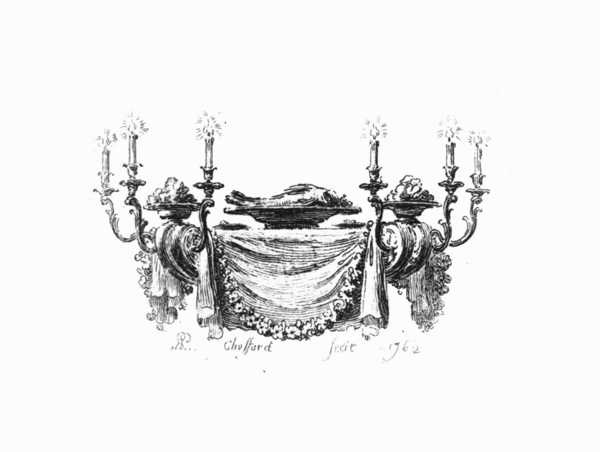
ATLAS MODERNE ou collection de cartes sur toutes les parties du globe terrestre par plusieurs auteurs. A Paris, chez Lattré et chez Delalain, small folio. A title-page and 73 maps; six of these have cartouches signed by Choffard. There are many others unsigned or bearing Arrivet’s or Marillier’s signature.
Paris, Hérissant, 1762, is printed on a later edition.
ALMANACH. Etrennes géographiques. Royaume de France divisé par généralités, sub-divisé par élections, diocèses, bailliages, etc., par L.-A. Ducaille, gravé par Lattré. Paris, Ballard, libraire, et aux Spectacles, 1760, 18mo. An ornamental title-page by Choffard and a frontispiece and maps by other artists.
BEAURAIN (Chevalier de). Histoire militaire de Flandre, depuis l’année 1690. jusqu’en 1694. inclusivement, etc., par le Chevalier de Beaurain. Paris, chez Le Chevalier de Beaurain, Ch. Nic. Poirion, Ch. Ant. Jombert, 1755, 2 vols., folio.
Volume I contains a frontispiece, 5 head-pieces and 5 tail-pieces. The last tail-piece in the volume is designed by Choffard, who also etched it, with the exception of the medal in the centre of the composition, which is engraved by Menil.
Volume II consists of 5 parts, starting by number I and contains an ornamental title-page and maps.
FÉNELON. Les aventures de Télemaque par Fénelon. De l’Imprimerie de Monsieur, 1785, 2 vols., folio. The woodcut of the arms of Monsieur, which is on the title-page of each volume, is engraved after Choffard.
This edition has a title-frontispiece, 72 plates, and 24 frames containing summaries and tail-pieces.
HÉRÉ. Plans et elevations de la Place Royale de Nancy et des autres edifices qui l’environnent bâties par les ordres du Roy de Pologne Duc de Lorraine. Dédiés au Roy de France par Héré premier architecte de sa Majesté polonoise. Paris, François, graveur, 1753, folio. An ornamental title-page, a frontispiece, a dedication page, and 13 folded architectural plates.
Choffard designed and etched the title-page; the frame round the dedication is etched by Choffard after François.
JANEL. Recueil de diligences, berlines, et carosses inventés et dessinés par Janel. Paris, Chéreau, oblong folio. 6 parts each containing 6 plates; these 36 illustrations were engraved under Choffard’s direction.
JOMBERT (Charles-Antoine). L’architecture moderne ou l’art de bien bâtir, pour toutes sortes de personnes, divisés en 10 livres. Paris, 1764, 4to. A frontispiece, head-pieces and architectural drawings by Choffard and other artists.
LA TOUR (Abbé de). Trois femmes, nouvelle. Seconde édition ornée de sept estampes dessinées par Legrand, et gravées à Paris par les meilleurs artistes. Leipsic, Pierre Philippe Wolff, 1798, 12mo. A frontispiece and 6 plates by Legrand, engraved by Choffard, Couché, and Duplessi-Bertaux.
These plates appear in “Recueil de nouvelles et autres écrits divers,” by the Abbé de la Tour, Leipsig, Pierre Philippe Wolff, 1798-1799, 3 vols., 12mo. They are also published in “Les trois femmes,” by Madame de Charrière.
See Charrière.
All the reproductions are from illustrations etched or engraved by Choffard after his own designs and are practically the size of the originals, unless otherwise stated.
The reproduction facing the frontispiece is after Choffard’s visiting card.
| PAGE | |
| A elle | 37 |
| Abrégé de la vie des plus fameux peintres | 38 |
| Almanach du chasseur | 37 |
| Almanach iconologique | 67, 68 |
| Amours du Chevalier de Faublas, Les | 76 |
| Amusements d’un convalescent | 37 |
| Architecture moderne, L’ | 100 |
| Arsace et Isménie | 39 |
| Art de conduire et de régler les pendules, L’ | 48 |
| Arte y puntual explicacion del modo de tocar el violin | 39 |
| Atala-René | 58 |
| Atlas géographique et militaire | 95 |
| Atlas moderne | 97 |
| Atlas topographique des environs de Paris | 39 |
| Atlas universel | 93, 59 |
| Aventures de Télémaque, Les | 66, 98 |
| Bijoux des neuf sœurs, Les | 83 |
| Cabinet des Fées | 54 |
| Cahiers de projets d’architectures | 62 |
| Carte géo-hydrographique du Golfe du Mexique | 96 |
| Cartes et tables de la géographie | 55 |
| Catalogue des chevaliers, etc., de l’ordre du Saint-Esprit | 56 |
| Catalogue ... des différens objets: ... qui composoient le cabinet de feu M. Mariette | 42 |
| Catalogue des planches gravées qui composent le fonds de Basan | 57 |
| Catalogue ... d’un choix ... de dessins, etc., qui composaient le cabinet de feu P.-F. Basan père | 85 |
| Catalogue d’une belle collection de dessins, etc., le tout rassemblé ... par M. Neyman | 42, 43 |
| Chansons nouvelles | 82 |
| Code du Bonheur | 65 |
| Collection complète des œuvres de J.-J. Rousseau | 87 |
| Collection de culs de lampe et fleurons | 39 |
| Collection de cent vingt estampes, etc., qui composoient le cabinet de M. Poullain | 43 |
| Comédies de Térence, Les | 92 |
| Contes et nouvelles en vers | 71, 73 |
| Décameron, Le | 52 |
| Decamerone, Il | 51 |
| De la mesure du temps par les horloges | 49 |
| De la nature des choses | 77 |
| Description de la Place de Louis XV | 75 |
| Description des bains de Titus | 83 |
| Description géographique de la Guyane | 46 |
| Description géographique des débouquemens de Saint Domingue | 45, 48 |
| Description géographique des isles Antilles | 46, 47 |
| Description géographique du Golfe de Venise | 47, 48 |
| Description géographique, etc., de l’isle de Corse | 47 |
| Dictionnaire des graveurs | 43, 51 |
| Diversi trofei | 58 |
| Douze nouveaux quintetti | 53 |
| Eclaircissemens sur l’invention ... des nouvelles machines | 49 |
| Église Sainte Genevieve | 64 |
| Emile | 88 |
| Essai géographique sur les isles britanniques | 45 |
| Essai sur l’horlogerie | 48 |
| Estampes galantes des contes du Boccace | 53 |
| Etrennes galantes | 65, 66 |
| Etrennes géographiques | 97 |
| Fables choisies | 70 |
| Faits mémorables des empereurs de la Chine | 68 |
| Galerie du Palais-Royal | 61 |
| Grande sonate pour le piano forte | 91 |
| Héroïdes | 51 |
| Histoire amoureuse des gaules | 54 |
| Histoire ancienne | 69 |
| Histoire de la Maison de Bourbon | 62 |
| Histoire de la mesure du temps par les horloges | 50 |
| Histoire de Louis XV. par médailles | 69 |
| Histoire générale des provinces-unies | 90 |
| Histoire militaire de Flandre | 98 |
| Hydraulique naturelle, L’ | 93 |
| Iconologie par figures | 67 |
| Idée générale de la ville de Rheims | 70 |
| Idylles | 48 |
| Jardins, Les | 62 |
| Jugement de Paris, Le | 70 |
| Lettre de Sapho à Phaon | 51 |
| Lettres de deux amants | 86 |
| Lettres d’une péruvienne | 66 |
| Lettres en vers | 51 |
| Livre d’écussons et cartels | 59 |
| Manuel du chasseur | 57 |
| Maximes et réflexions morales | 74 |
| Métamorphoses d’Ovide, Les | 77, 81, 71 |
| Méthode pour le piano-forte | 83 |
| Notice historique sur l’art de la gravure en France | 59, 94 |
| Nouvel abrégé ... de l’histoire de France | 69 |
| Nouvelle Héloïse, La | 86 |
| Œuvres badines et morales | 57 |
| Œuvres complètes de Berquin | 48 |
| Œuvres complètes de M. Palissot | 82 |
| Œuvres de Jean Racine | 83, 84 |
| Œuvres de J.-J. Rousseau | 88 |
| Œuvres de M. Palissot | 81 |
| Orlando furioso | 38 |
| Plans et élévations de la Place royale de Nancy | 99 |
| Préjugés militaires | 75 |
| Pucelle d’Orléans, La | 94 |
| Recueil d’estampes gravées d’après les tableaux du cabinet de Monseigneur le Duc de Choiseul | 41 |
| Recueil de diligences, etc. | 99 |
| Recueil de nouvelles et autres écrits divers | 100 |
| Romance | 63 |
| Saisons, Les | 88, 89 |
| 2me. Suite de culs de lampe et fleurons | 40 |
| Supplément à l’abrégé de la vie des plus fameux peintres | 38 |
| Tableaux historiques de la révolution française | 91 |
| Tableaux historiques des campagnes d’Italie | 92 |
| Tancrède | 94 |
| Théâtre de P. Corneille | 61 |
| Traité des horloges marines | 49 |
| Traité des montres à longitude | 49 |
| Traité du beaux essentiel dans les arts | 54 |
| Trois femmes | 100 |
| Trois femmes, Les | 58, 100 |
| Troisième partie de la carte d’Europe | 38 |
| Victoires et conquêtes de l’Empereur de la Chine | 93 |
| Voyage pittoresque de la Grèce | 60 |
| Voyage pittoresque, ou déscription des royaumes de Naples et de Sicile | 89 |
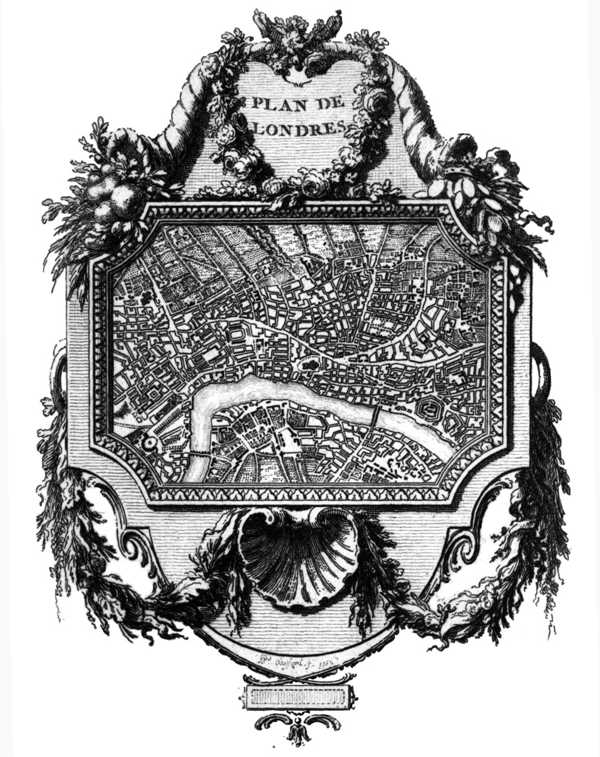
A vignette from “Essai géographique sur les
isles britanniques, etc.,” by Bellin, 1757.
Nearly the actual size.
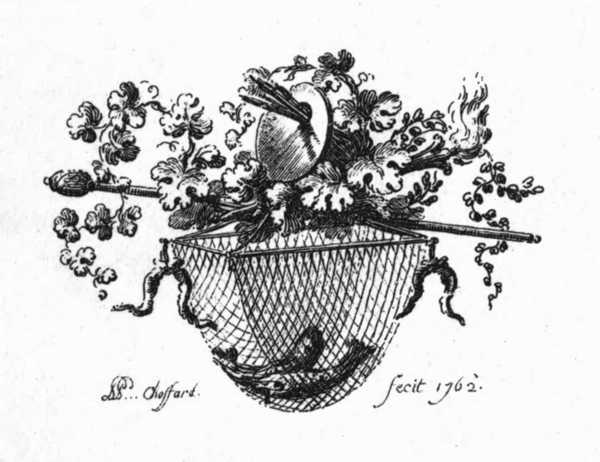
Tail-piece from “Contes et nouvelles en
vers,” by La Fontaine, 1762.
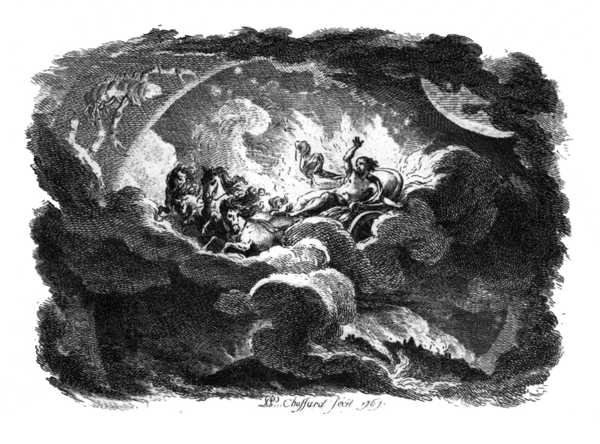
Head-piece from “Les métamorphoses
d’Ovide,” 1767-1771.
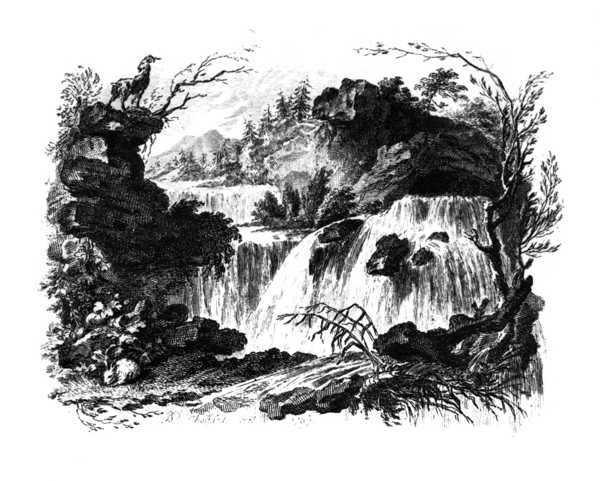
Head-piece from “Les métamorphoses
d’Ovide,” 1767-1771.
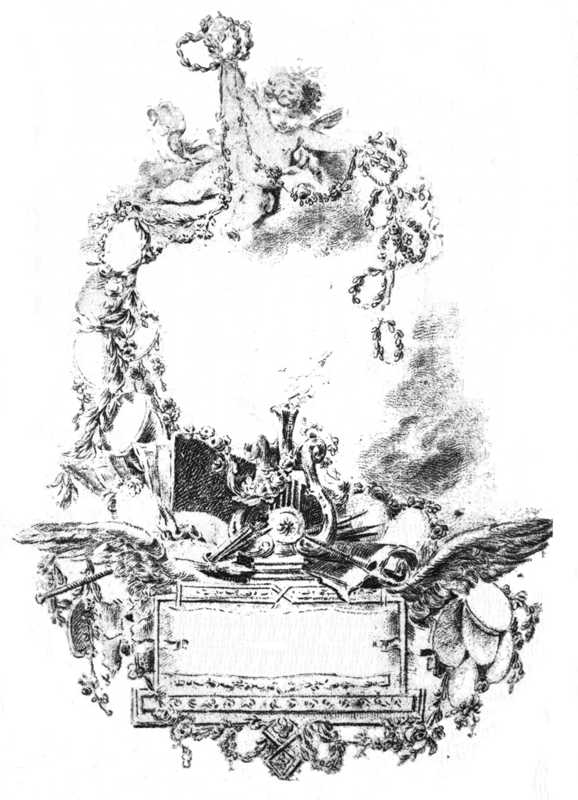
A drawing by Choffard for the tail-piece in
“Les métamorphoses d’Ovide,” 1767-1771
edition. Reduced.
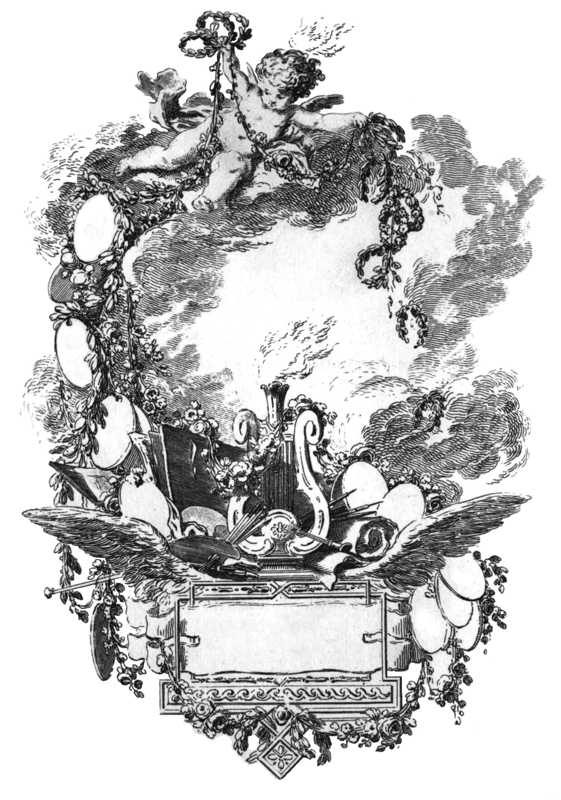
Eau-forte of the tail-piece, just mentioned,
in “Les métamorphoses d’Ovide,” 1767-1771
edition. Reduced.
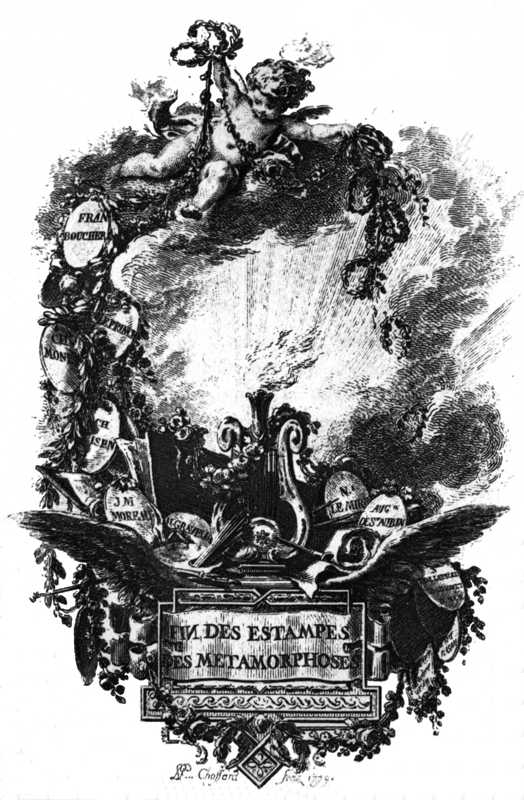
Finished plate of the foregoing tail-piece.
Reduced.
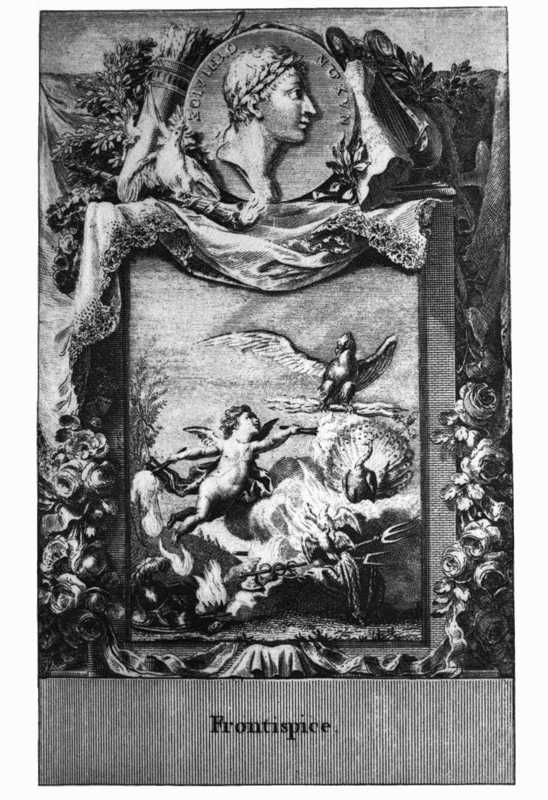
Frontispiece of a subsequent edition of “Les
métamorphoses d’Ovide.” It is a combination
of the decorated half-title and a fleuron
in the 1767-1771 edition of the
same book. Reduced.
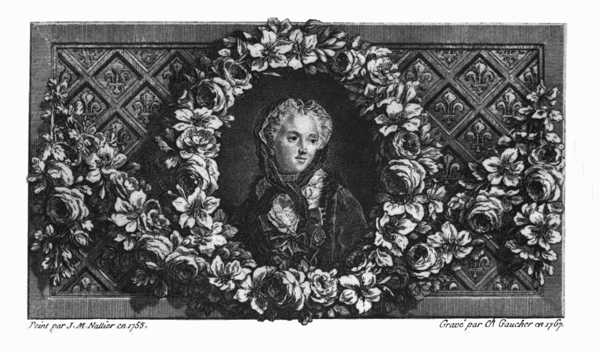
Vignette above the dedication to Queen Marie
Leczinska in “Nouvel abrégé chronologique
de l’histoire de France, etc.,” by Président
Hénault, 1768. The portrait is engraved
by Gaucher after Nattier and the
setting is by Choffard.
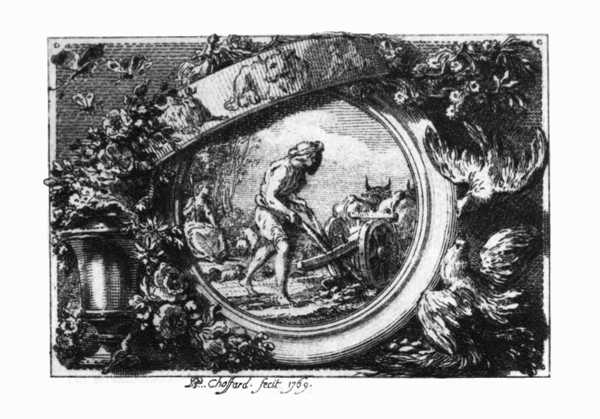
Head-piece from “Les saisons,” by Saint-Lambert,
1769.
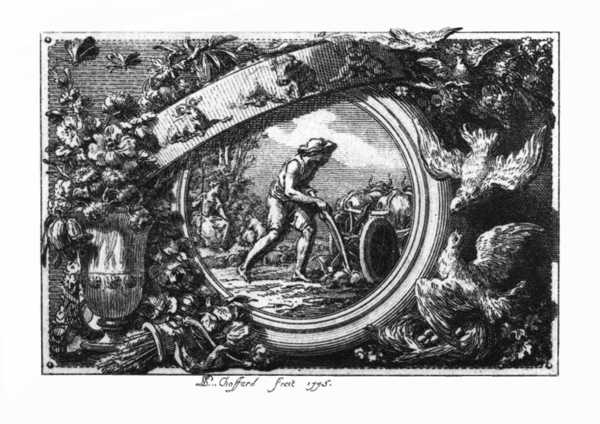
Head-piece from “Les saisons,” by Saint-Lambert,
1775.
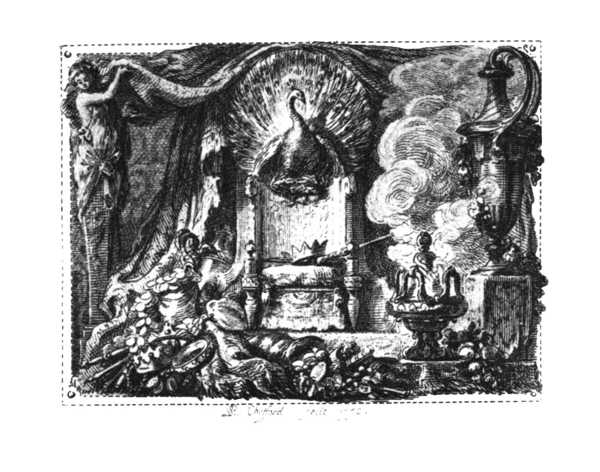
Head-piece from “Le jugement de Paris,”
by Imbert, 1772.
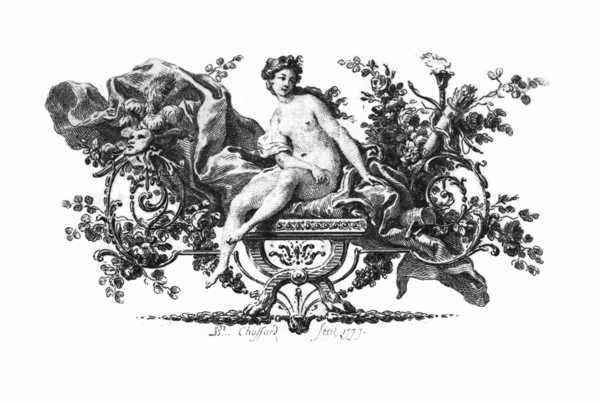
Fleuron on the title-page of volume vii of
“Collection complète des œuvres de
J.-J. Rousseau,” 1774-1783.
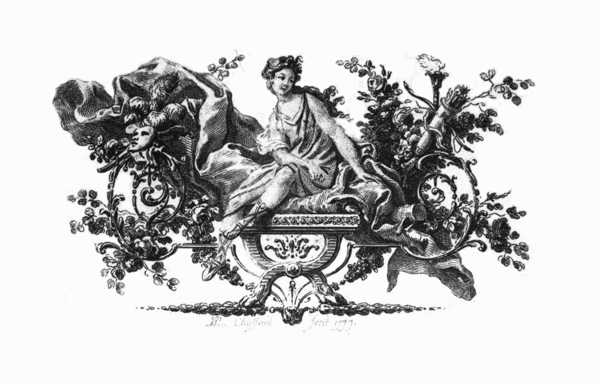
The same illustration as the preceding one,
only draped. This plate was never published
and is cited nowhere.
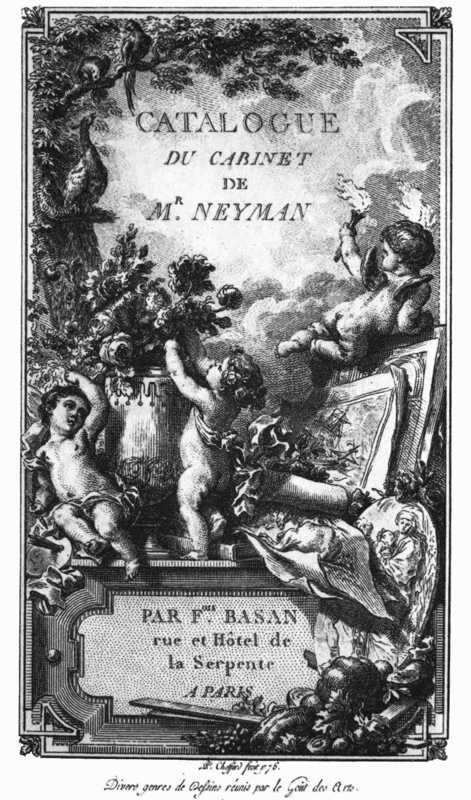
Decorative title-page of “Catalogue du
cabinet de Mr. Neyman,” by Basan,
1776. Slightly reduced.
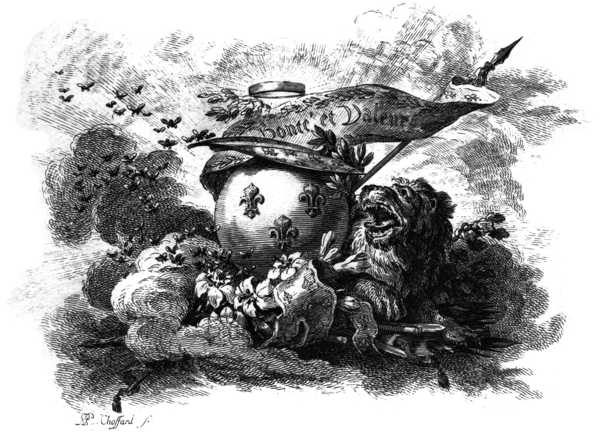
Fleuron on the title-page of volume 1 of
“Histoire de la maison de Bourbon,”
by Désormeaux, 1779-1788.
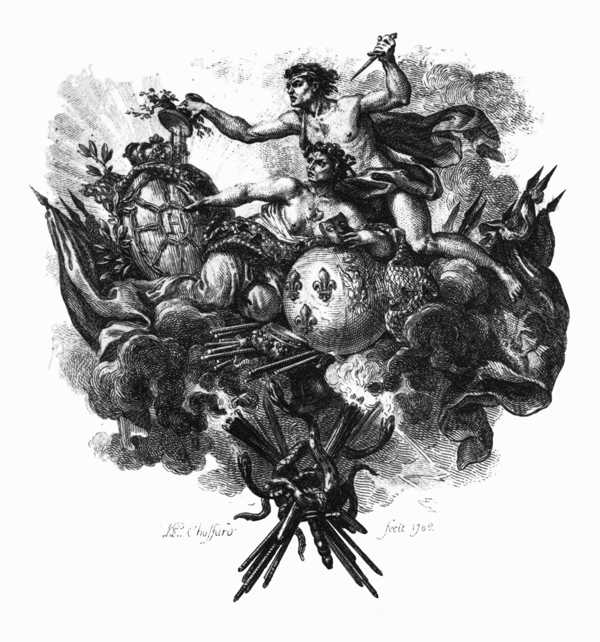
Tail-piece from “Histoire de la maison
de Bourbon,” by Désormeaux, 1779-1788.
Slightly reduced.
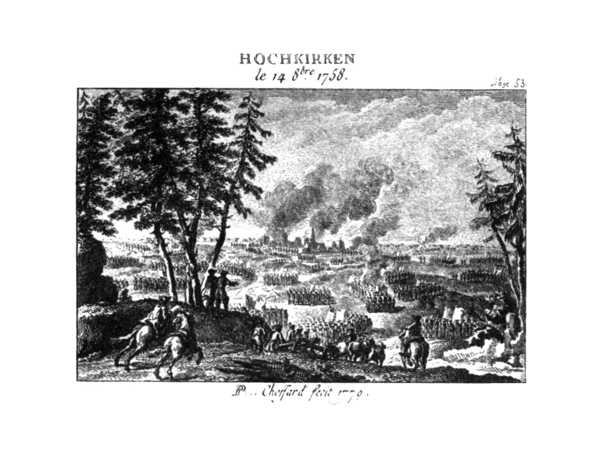
Head-piece from “Préjugés militaires,”
by the Prince de Ligne, 1780.
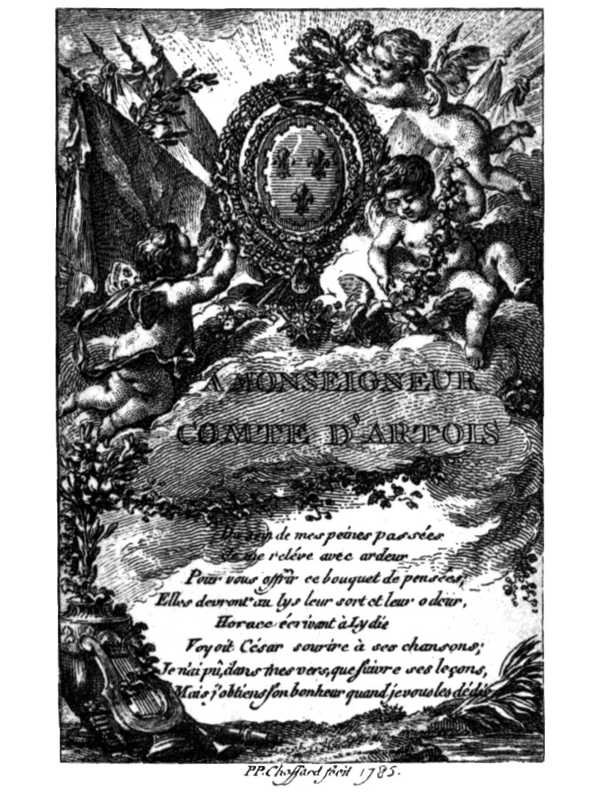
Dedication vignette in “Chansons nouvelles,”
by de Piis, 1785.
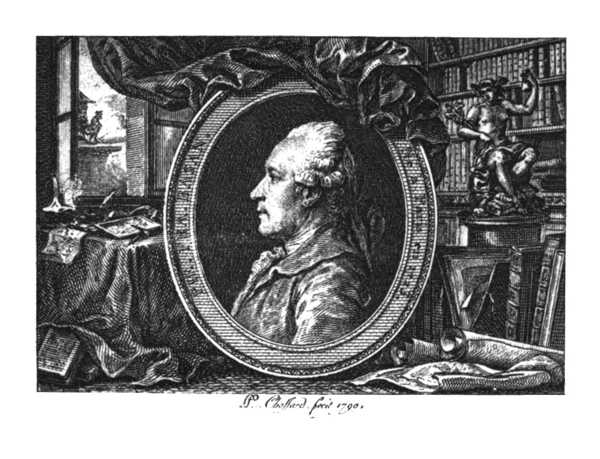
Head-piece in volume ii of “Dictionnaire
des graveurs, etc.,” by Basan, 1789.
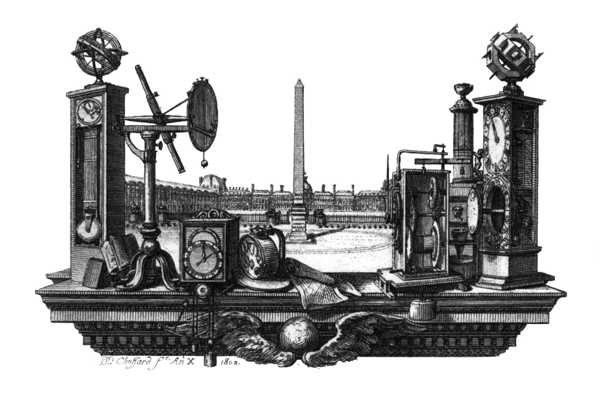
Fleuron on the title-page of “Histoire de la
mesure du temps par les horloges,” by
Ferdinand Berthoud, 1802.
1. Silently corrected typographical errors and inconsistencies; retained non-standard spelling.
2. Added one line in the TOC to include the Index
3. The descriptions of the illustrations have been moved under each illustration.
End of the Project Gutenberg EBook of Choffard, by Vera Salomons
*** END OF THIS PROJECT GUTENBERG EBOOK CHOFFARD ***
***** This file should be named 47998-h.htm or 47998-h.zip *****
This and all associated files of various formats will be found in:
http://www.gutenberg.org/4/7/9/9/47998/
Produced by Chris Curnow, Denis Pronovost and the Online
Distributed Proofreading Team at http://www.pgdp.net (This
file was produced from images generously made available
by The Internet Archive)
Updated editions will replace the previous one--the old editions will
be renamed.
Creating the works from print editions not protected by U.S. copyright
law means that no one owns a United States copyright in these works,
so the Foundation (and you!) can copy and distribute it in the United
States without permission and without paying copyright
royalties. Special rules, set forth in the General Terms of Use part
of this license, apply to copying and distributing Project
Gutenberg-tm electronic works to protect the PROJECT GUTENBERG-tm
concept and trademark. Project Gutenberg is a registered trademark,
and may not be used if you charge for the eBooks, unless you receive
specific permission. If you do not charge anything for copies of this
eBook, complying with the rules is very easy. You may use this eBook
for nearly any purpose such as creation of derivative works, reports,
performances and research. They may be modified and printed and given
away--you may do practically ANYTHING in the United States with eBooks
not protected by U.S. copyright law. Redistribution is subject to the
trademark license, especially commercial redistribution.
START: FULL LICENSE
THE FULL PROJECT GUTENBERG LICENSE
PLEASE READ THIS BEFORE YOU DISTRIBUTE OR USE THIS WORK
To protect the Project Gutenberg-tm mission of promoting the free
distribution of electronic works, by using or distributing this work
(or any other work associated in any way with the phrase "Project
Gutenberg"), you agree to comply with all the terms of the Full
Project Gutenberg-tm License available with this file or online at
www.gutenberg.org/license.
Section 1. General Terms of Use and Redistributing Project
Gutenberg-tm electronic works
1.A. By reading or using any part of this Project Gutenberg-tm
electronic work, you indicate that you have read, understand, agree to
and accept all the terms of this license and intellectual property
(trademark/copyright) agreement. If you do not agree to abide by all
the terms of this agreement, you must cease using and return or
destroy all copies of Project Gutenberg-tm electronic works in your
possession. If you paid a fee for obtaining a copy of or access to a
Project Gutenberg-tm electronic work and you do not agree to be bound
by the terms of this agreement, you may obtain a refund from the
person or entity to whom you paid the fee as set forth in paragraph
1.E.8.
1.B. "Project Gutenberg" is a registered trademark. It may only be
used on or associated in any way with an electronic work by people who
agree to be bound by the terms of this agreement. There are a few
things that you can do with most Project Gutenberg-tm electronic works
even without complying with the full terms of this agreement. See
paragraph 1.C below. There are a lot of things you can do with Project
Gutenberg-tm electronic works if you follow the terms of this
agreement and help preserve free future access to Project Gutenberg-tm
electronic works. See paragraph 1.E below.
1.C. The Project Gutenberg Literary Archive Foundation ("the
Foundation" or PGLAF), owns a compilation copyright in the collection
of Project Gutenberg-tm electronic works. Nearly all the individual
works in the collection are in the public domain in the United
States. If an individual work is unprotected by copyright law in the
United States and you are located in the United States, we do not
claim a right to prevent you from copying, distributing, performing,
displaying or creating derivative works based on the work as long as
all references to Project Gutenberg are removed. Of course, we hope
that you will support the Project Gutenberg-tm mission of promoting
free access to electronic works by freely sharing Project Gutenberg-tm
works in compliance with the terms of this agreement for keeping the
Project Gutenberg-tm name associated with the work. You can easily
comply with the terms of this agreement by keeping this work in the
same format with its attached full Project Gutenberg-tm License when
you share it without charge with others.
1.D. The copyright laws of the place where you are located also govern
what you can do with this work. Copyright laws in most countries are
in a constant state of change. If you are outside the United States,
check the laws of your country in addition to the terms of this
agreement before downloading, copying, displaying, performing,
distributing or creating derivative works based on this work or any
other Project Gutenberg-tm work. The Foundation makes no
representations concerning the copyright status of any work in any
country outside the United States.
1.E. Unless you have removed all references to Project Gutenberg:
1.E.1. The following sentence, with active links to, or other
immediate access to, the full Project Gutenberg-tm License must appear
prominently whenever any copy of a Project Gutenberg-tm work (any work
on which the phrase "Project Gutenberg" appears, or with which the
phrase "Project Gutenberg" is associated) is accessed, displayed,
performed, viewed, copied or distributed:
This eBook is for the use of anyone anywhere in the United States and
most other parts of the world at no cost and with almost no
restrictions whatsoever. You may copy it, give it away or re-use it
under the terms of the Project Gutenberg License included with this
eBook or online at www.gutenberg.org. If you are not located in the
United States, you'll have to check the laws of the country where you
are located before using this ebook.
1.E.2. If an individual Project Gutenberg-tm electronic work is
derived from texts not protected by U.S. copyright law (does not
contain a notice indicating that it is posted with permission of the
copyright holder), the work can be copied and distributed to anyone in
the United States without paying any fees or charges. If you are
redistributing or providing access to a work with the phrase "Project
Gutenberg" associated with or appearing on the work, you must comply
either with the requirements of paragraphs 1.E.1 through 1.E.7 or
obtain permission for the use of the work and the Project Gutenberg-tm
trademark as set forth in paragraphs 1.E.8 or 1.E.9.
1.E.3. If an individual Project Gutenberg-tm electronic work is posted
with the permission of the copyright holder, your use and distribution
must comply with both paragraphs 1.E.1 through 1.E.7 and any
additional terms imposed by the copyright holder. Additional terms
will be linked to the Project Gutenberg-tm License for all works
posted with the permission of the copyright holder found at the
beginning of this work.
1.E.4. Do not unlink or detach or remove the full Project Gutenberg-tm
License terms from this work, or any files containing a part of this
work or any other work associated with Project Gutenberg-tm.
1.E.5. Do not copy, display, perform, distribute or redistribute this
electronic work, or any part of this electronic work, without
prominently displaying the sentence set forth in paragraph 1.E.1 with
active links or immediate access to the full terms of the Project
Gutenberg-tm License.
1.E.6. You may convert to and distribute this work in any binary,
compressed, marked up, nonproprietary or proprietary form, including
any word processing or hypertext form. However, if you provide access
to or distribute copies of a Project Gutenberg-tm work in a format
other than "Plain Vanilla ASCII" or other format used in the official
version posted on the official Project Gutenberg-tm web site
(www.gutenberg.org), you must, at no additional cost, fee or expense
to the user, provide a copy, a means of exporting a copy, or a means
of obtaining a copy upon request, of the work in its original "Plain
Vanilla ASCII" or other form. Any alternate format must include the
full Project Gutenberg-tm License as specified in paragraph 1.E.1.
1.E.7. Do not charge a fee for access to, viewing, displaying,
performing, copying or distributing any Project Gutenberg-tm works
unless you comply with paragraph 1.E.8 or 1.E.9.
1.E.8. You may charge a reasonable fee for copies of or providing
access to or distributing Project Gutenberg-tm electronic works
provided that
* You pay a royalty fee of 20% of the gross profits you derive from
the use of Project Gutenberg-tm works calculated using the method
you already use to calculate your applicable taxes. The fee is owed
to the owner of the Project Gutenberg-tm trademark, but he has
agreed to donate royalties under this paragraph to the Project
Gutenberg Literary Archive Foundation. Royalty payments must be paid
within 60 days following each date on which you prepare (or are
legally required to prepare) your periodic tax returns. Royalty
payments should be clearly marked as such and sent to the Project
Gutenberg Literary Archive Foundation at the address specified in
Section 4, "Information about donations to the Project Gutenberg
Literary Archive Foundation."
* You provide a full refund of any money paid by a user who notifies
you in writing (or by e-mail) within 30 days of receipt that s/he
does not agree to the terms of the full Project Gutenberg-tm
License. You must require such a user to return or destroy all
copies of the works possessed in a physical medium and discontinue
all use of and all access to other copies of Project Gutenberg-tm
works.
* You provide, in accordance with paragraph 1.F.3, a full refund of
any money paid for a work or a replacement copy, if a defect in the
electronic work is discovered and reported to you within 90 days of
receipt of the work.
* You comply with all other terms of this agreement for free
distribution of Project Gutenberg-tm works.
1.E.9. If you wish to charge a fee or distribute a Project
Gutenberg-tm electronic work or group of works on different terms than
are set forth in this agreement, you must obtain permission in writing
from both the Project Gutenberg Literary Archive Foundation and The
Project Gutenberg Trademark LLC, the owner of the Project Gutenberg-tm
trademark. Contact the Foundation as set forth in Section 3 below.
1.F.
1.F.1. Project Gutenberg volunteers and employees expend considerable
effort to identify, do copyright research on, transcribe and proofread
works not protected by U.S. copyright law in creating the Project
Gutenberg-tm collection. Despite these efforts, Project Gutenberg-tm
electronic works, and the medium on which they may be stored, may
contain "Defects," such as, but not limited to, incomplete, inaccurate
or corrupt data, transcription errors, a copyright or other
intellectual property infringement, a defective or damaged disk or
other medium, a computer virus, or computer codes that damage or
cannot be read by your equipment.
1.F.2. LIMITED WARRANTY, DISCLAIMER OF DAMAGES - Except for the "Right
of Replacement or Refund" described in paragraph 1.F.3, the Project
Gutenberg Literary Archive Foundation, the owner of the Project
Gutenberg-tm trademark, and any other party distributing a Project
Gutenberg-tm electronic work under this agreement, disclaim all
liability to you for damages, costs and expenses, including legal
fees. YOU AGREE THAT YOU HAVE NO REMEDIES FOR NEGLIGENCE, STRICT
LIABILITY, BREACH OF WARRANTY OR BREACH OF CONTRACT EXCEPT THOSE
PROVIDED IN PARAGRAPH 1.F.3. YOU AGREE THAT THE FOUNDATION, THE
TRADEMARK OWNER, AND ANY DISTRIBUTOR UNDER THIS AGREEMENT WILL NOT BE
LIABLE TO YOU FOR ACTUAL, DIRECT, INDIRECT, CONSEQUENTIAL, PUNITIVE OR
INCIDENTAL DAMAGES EVEN IF YOU GIVE NOTICE OF THE POSSIBILITY OF SUCH
DAMAGE.
1.F.3. LIMITED RIGHT OF REPLACEMENT OR REFUND - If you discover a
defect in this electronic work within 90 days of receiving it, you can
receive a refund of the money (if any) you paid for it by sending a
written explanation to the person you received the work from. If you
received the work on a physical medium, you must return the medium
with your written explanation. The person or entity that provided you
with the defective work may elect to provide a replacement copy in
lieu of a refund. If you received the work electronically, the person
or entity providing it to you may choose to give you a second
opportunity to receive the work electronically in lieu of a refund. If
the second copy is also defective, you may demand a refund in writing
without further opportunities to fix the problem.
1.F.4. Except for the limited right of replacement or refund set forth
in paragraph 1.F.3, this work is provided to you 'AS-IS', WITH NO
OTHER WARRANTIES OF ANY KIND, EXPRESS OR IMPLIED, INCLUDING BUT NOT
LIMITED TO WARRANTIES OF MERCHANTABILITY OR FITNESS FOR ANY PURPOSE.
1.F.5. Some states do not allow disclaimers of certain implied
warranties or the exclusion or limitation of certain types of
damages. If any disclaimer or limitation set forth in this agreement
violates the law of the state applicable to this agreement, the
agreement shall be interpreted to make the maximum disclaimer or
limitation permitted by the applicable state law. The invalidity or
unenforceability of any provision of this agreement shall not void the
remaining provisions.
1.F.6. INDEMNITY - You agree to indemnify and hold the Foundation, the
trademark owner, any agent or employee of the Foundation, anyone
providing copies of Project Gutenberg-tm electronic works in
accordance with this agreement, and any volunteers associated with the
production, promotion and distribution of Project Gutenberg-tm
electronic works, harmless from all liability, costs and expenses,
including legal fees, that arise directly or indirectly from any of
the following which you do or cause to occur: (a) distribution of this
or any Project Gutenberg-tm work, (b) alteration, modification, or
additions or deletions to any Project Gutenberg-tm work, and (c) any
Defect you cause.
Section 2. Information about the Mission of Project Gutenberg-tm
Project Gutenberg-tm is synonymous with the free distribution of
electronic works in formats readable by the widest variety of
computers including obsolete, old, middle-aged and new computers. It
exists because of the efforts of hundreds of volunteers and donations
from people in all walks of life.
Volunteers and financial support to provide volunteers with the
assistance they need are critical to reaching Project Gutenberg-tm's
goals and ensuring that the Project Gutenberg-tm collection will
remain freely available for generations to come. In 2001, the Project
Gutenberg Literary Archive Foundation was created to provide a secure
and permanent future for Project Gutenberg-tm and future
generations. To learn more about the Project Gutenberg Literary
Archive Foundation and how your efforts and donations can help, see
Sections 3 and 4 and the Foundation information page at
www.gutenberg.org
Section 3. Information about the Project Gutenberg Literary Archive Foundation
The Project Gutenberg Literary Archive Foundation is a non profit
501(c)(3) educational corporation organized under the laws of the
state of Mississippi and granted tax exempt status by the Internal
Revenue Service. The Foundation's EIN or federal tax identification
number is 64-6221541. Contributions to the Project Gutenberg Literary
Archive Foundation are tax deductible to the full extent permitted by
U.S. federal laws and your state's laws.
The Foundation's principal office is in Fairbanks, Alaska, with the
mailing address: PO Box 750175, Fairbanks, AK 99775, but its
volunteers and employees are scattered throughout numerous
locations. Its business office is located at 809 North 1500 West, Salt
Lake City, UT 84116, (801) 596-1887. Email contact links and up to
date contact information can be found at the Foundation's web site and
official page at www.gutenberg.org/contact
For additional contact information:
Dr. Gregory B. Newby
Chief Executive and Director
gbnewby@pglaf.org
Section 4. Information about Donations to the Project Gutenberg
Literary Archive Foundation
Project Gutenberg-tm depends upon and cannot survive without wide
spread public support and donations to carry out its mission of
increasing the number of public domain and licensed works that can be
freely distributed in machine readable form accessible by the widest
array of equipment including outdated equipment. Many small donations
($1 to $5,000) are particularly important to maintaining tax exempt
status with the IRS.
The Foundation is committed to complying with the laws regulating
charities and charitable donations in all 50 states of the United
States. Compliance requirements are not uniform and it takes a
considerable effort, much paperwork and many fees to meet and keep up
with these requirements. We do not solicit donations in locations
where we have not received written confirmation of compliance. To SEND
DONATIONS or determine the status of compliance for any particular
state visit www.gutenberg.org/donate
While we cannot and do not solicit contributions from states where we
have not met the solicitation requirements, we know of no prohibition
against accepting unsolicited donations from donors in such states who
approach us with offers to donate.
International donations are gratefully accepted, but we cannot make
any statements concerning tax treatment of donations received from
outside the United States. U.S. laws alone swamp our small staff.
Please check the Project Gutenberg Web pages for current donation
methods and addresses. Donations are accepted in a number of other
ways including checks, online payments and credit card donations. To
donate, please visit: www.gutenberg.org/donate
Section 5. General Information About Project Gutenberg-tm electronic works.
Professor Michael S. Hart was the originator of the Project
Gutenberg-tm concept of a library of electronic works that could be
freely shared with anyone. For forty years, he produced and
distributed Project Gutenberg-tm eBooks with only a loose network of
volunteer support.
Project Gutenberg-tm eBooks are often created from several printed
editions, all of which are confirmed as not protected by copyright in
the U.S. unless a copyright notice is included. Thus, we do not
necessarily keep eBooks in compliance with any particular paper
edition.
Most people start at our Web site which has the main PG search
facility: www.gutenberg.org
This Web site includes information about Project Gutenberg-tm,
including how to make donations to the Project Gutenberg Literary
Archive Foundation, how to help produce our new eBooks, and how to
subscribe to our email newsletter to hear about new eBooks.